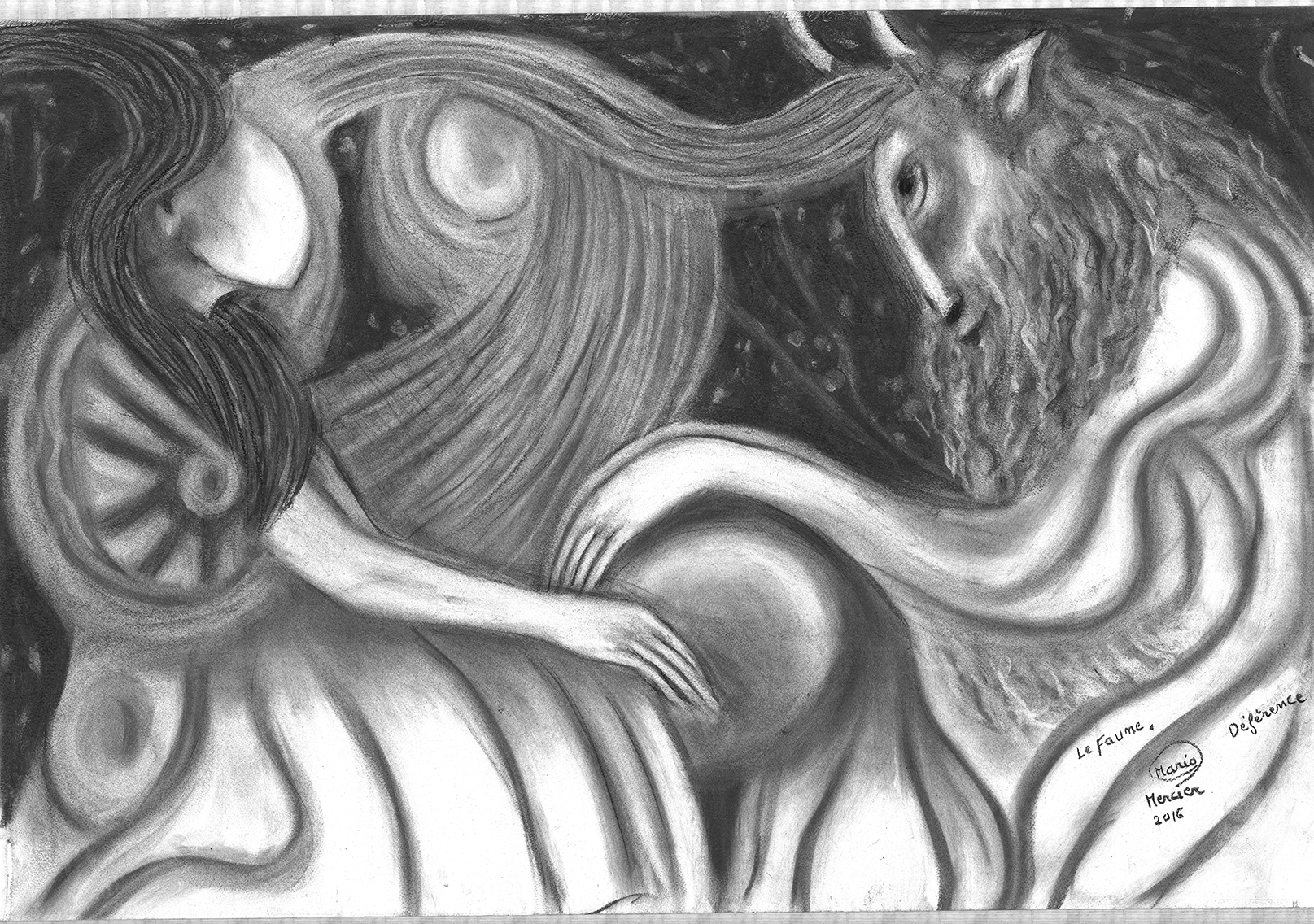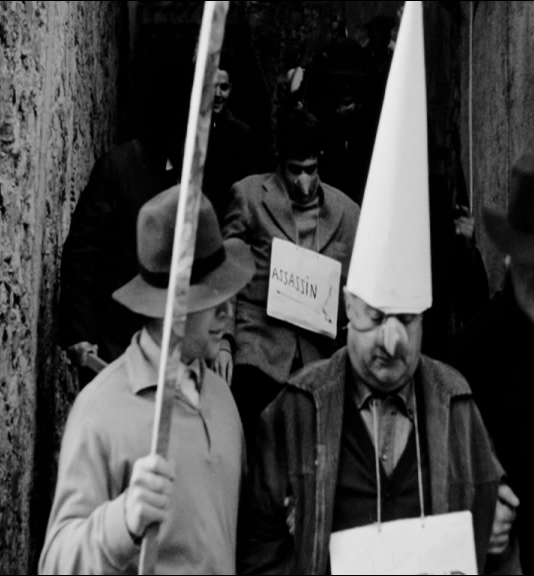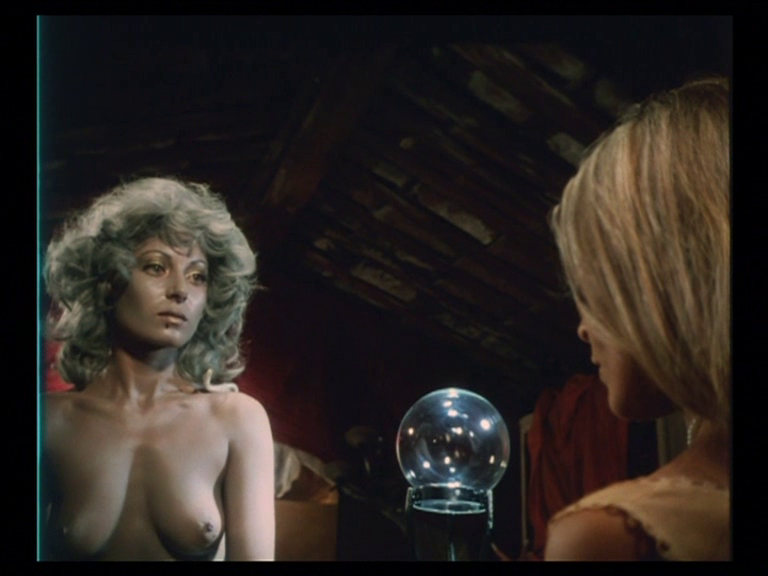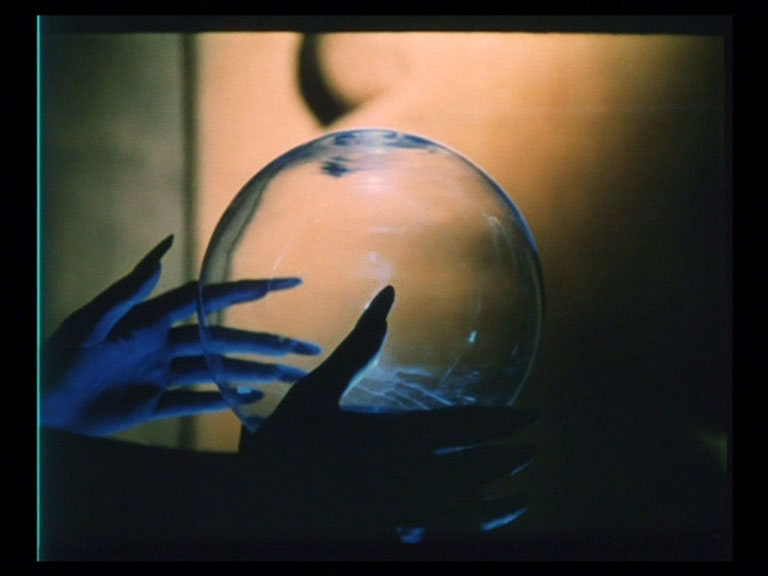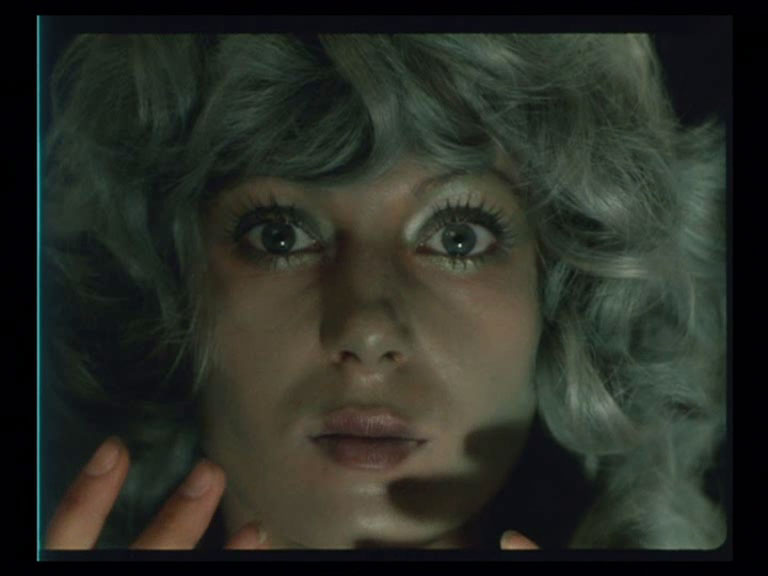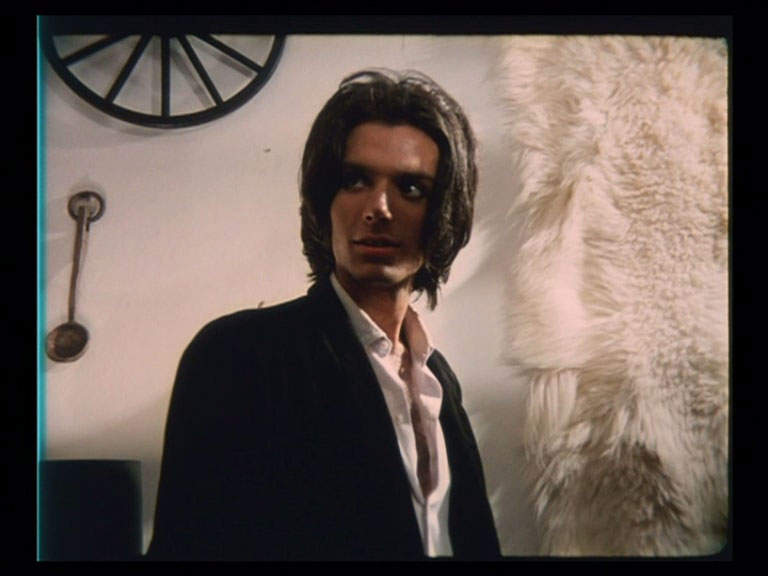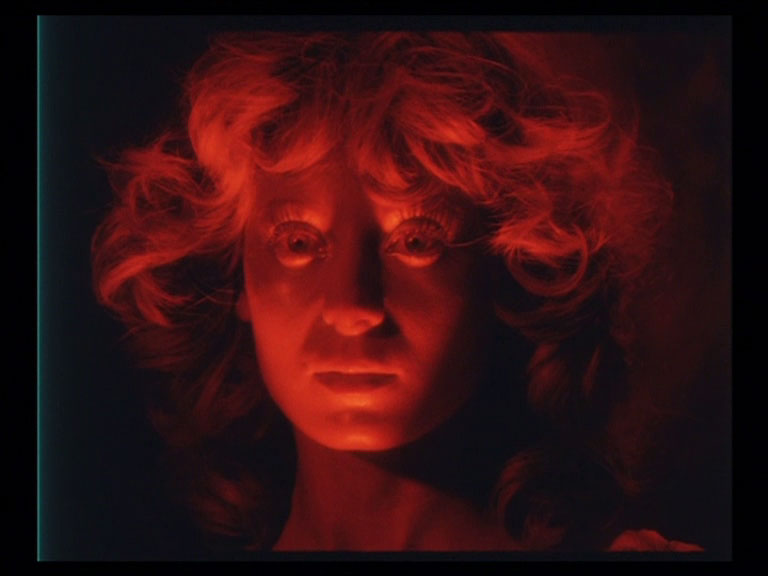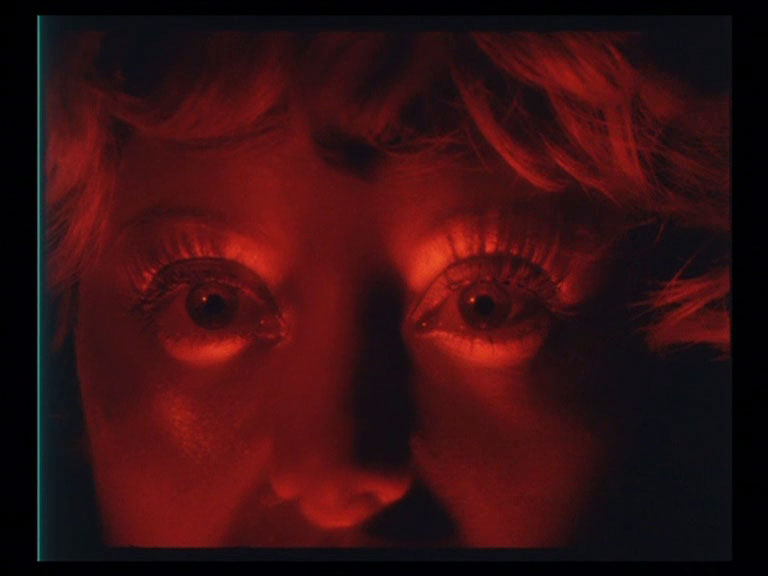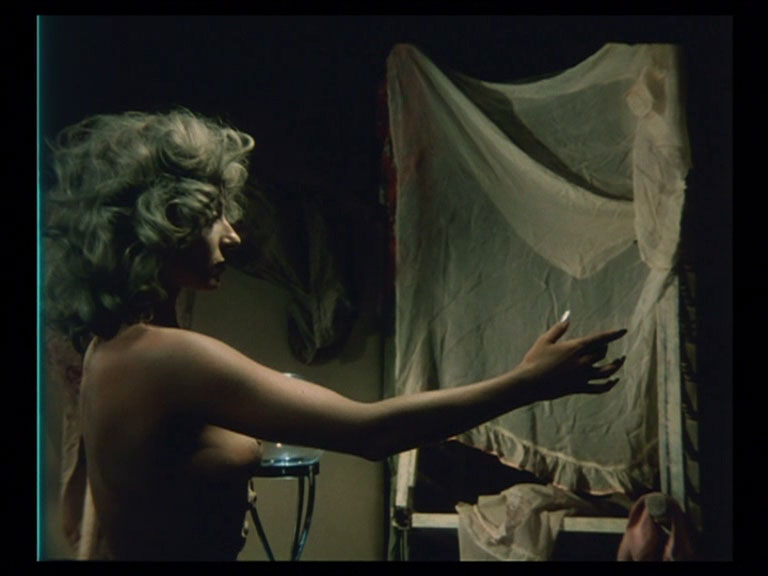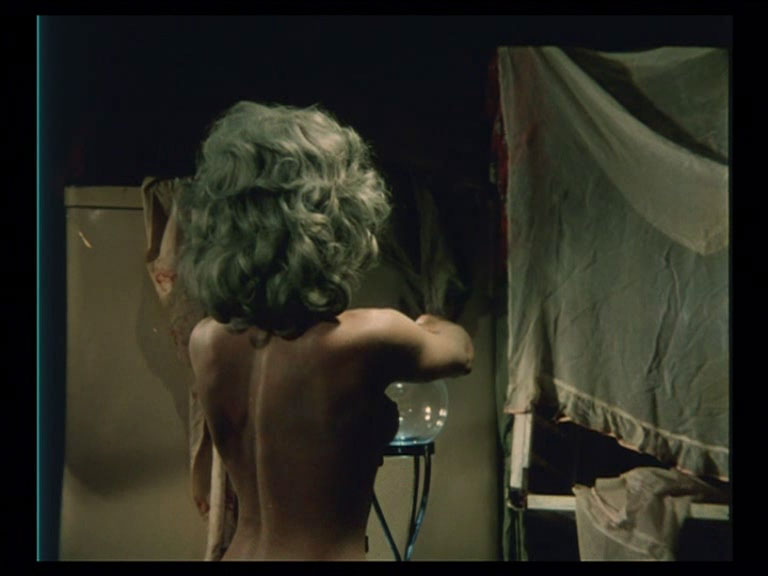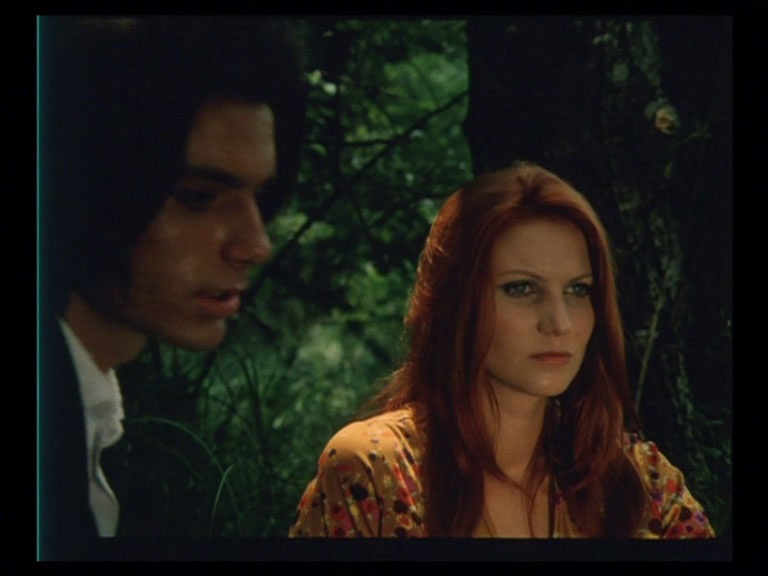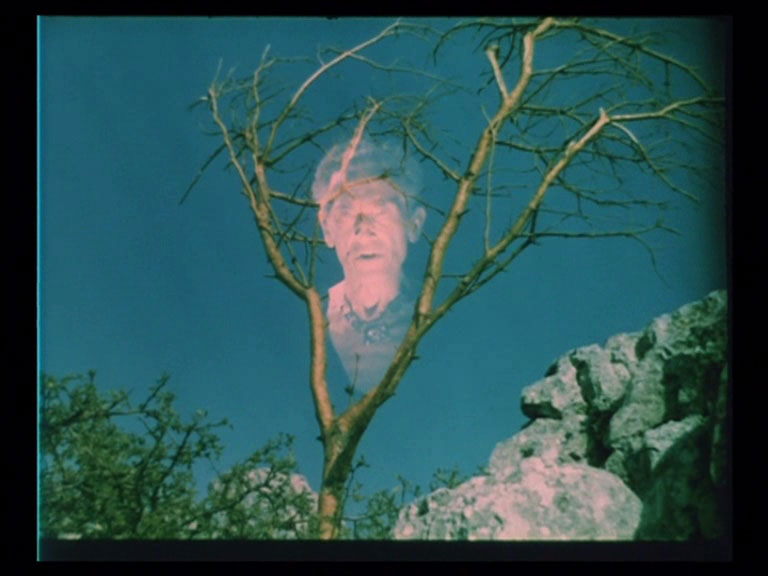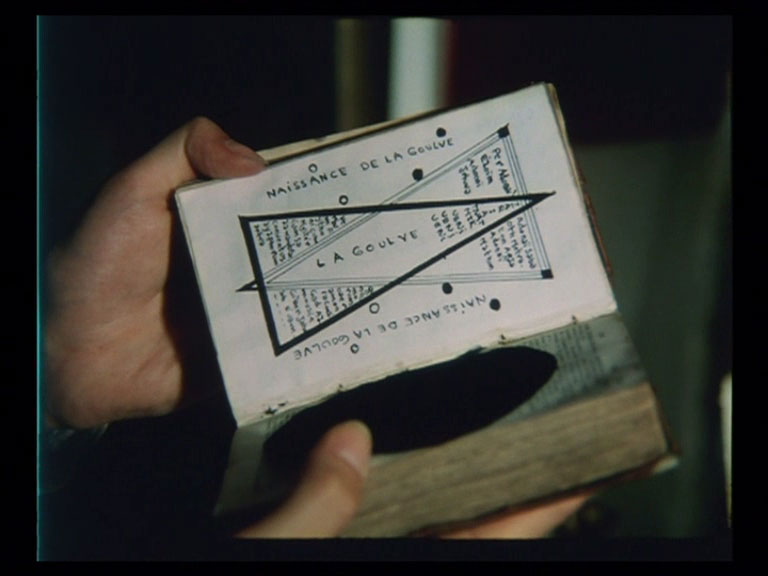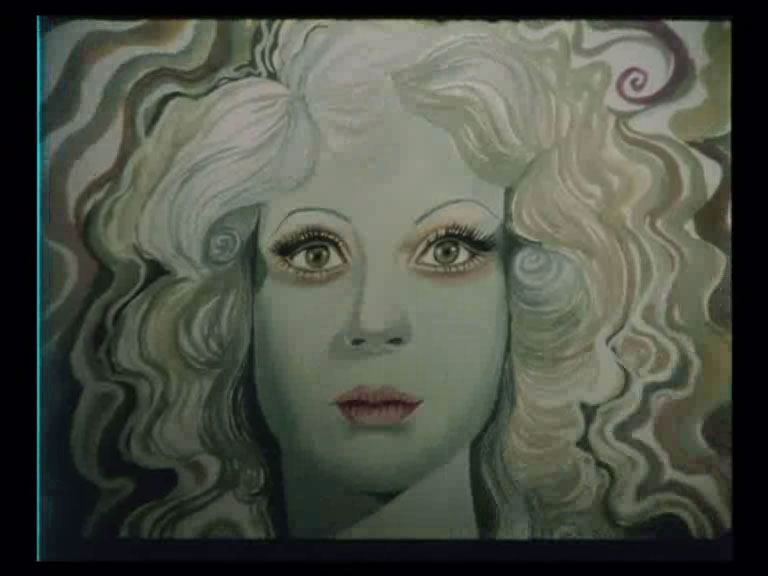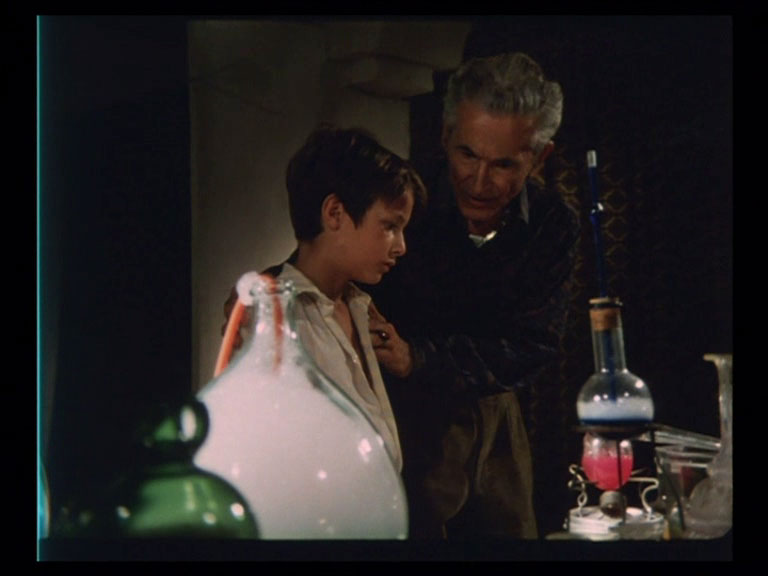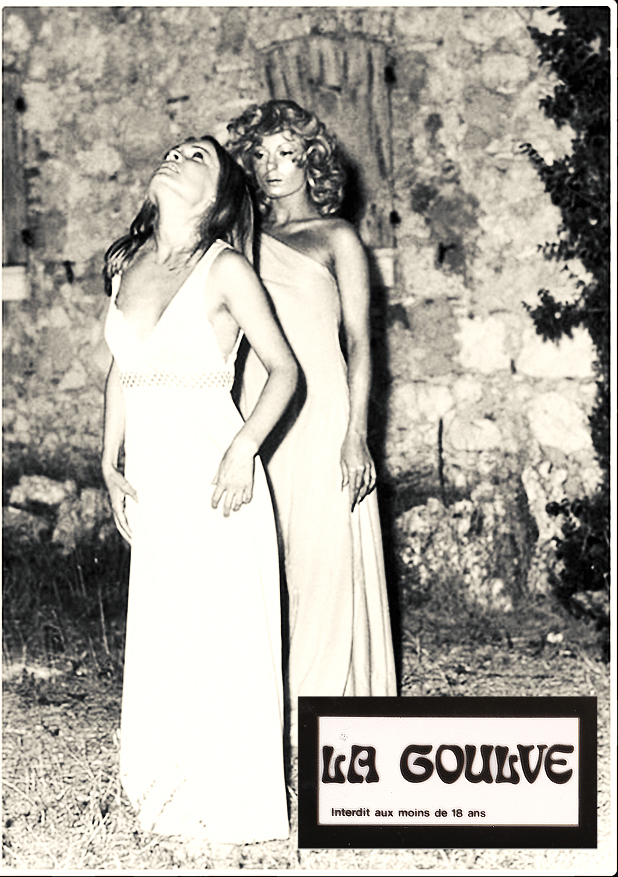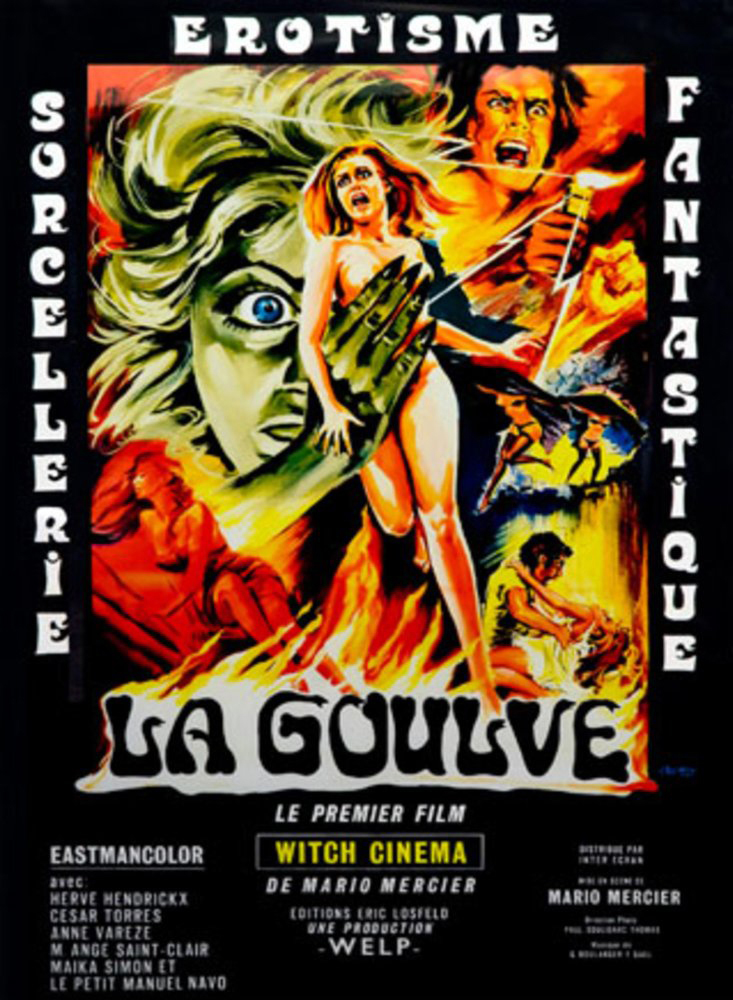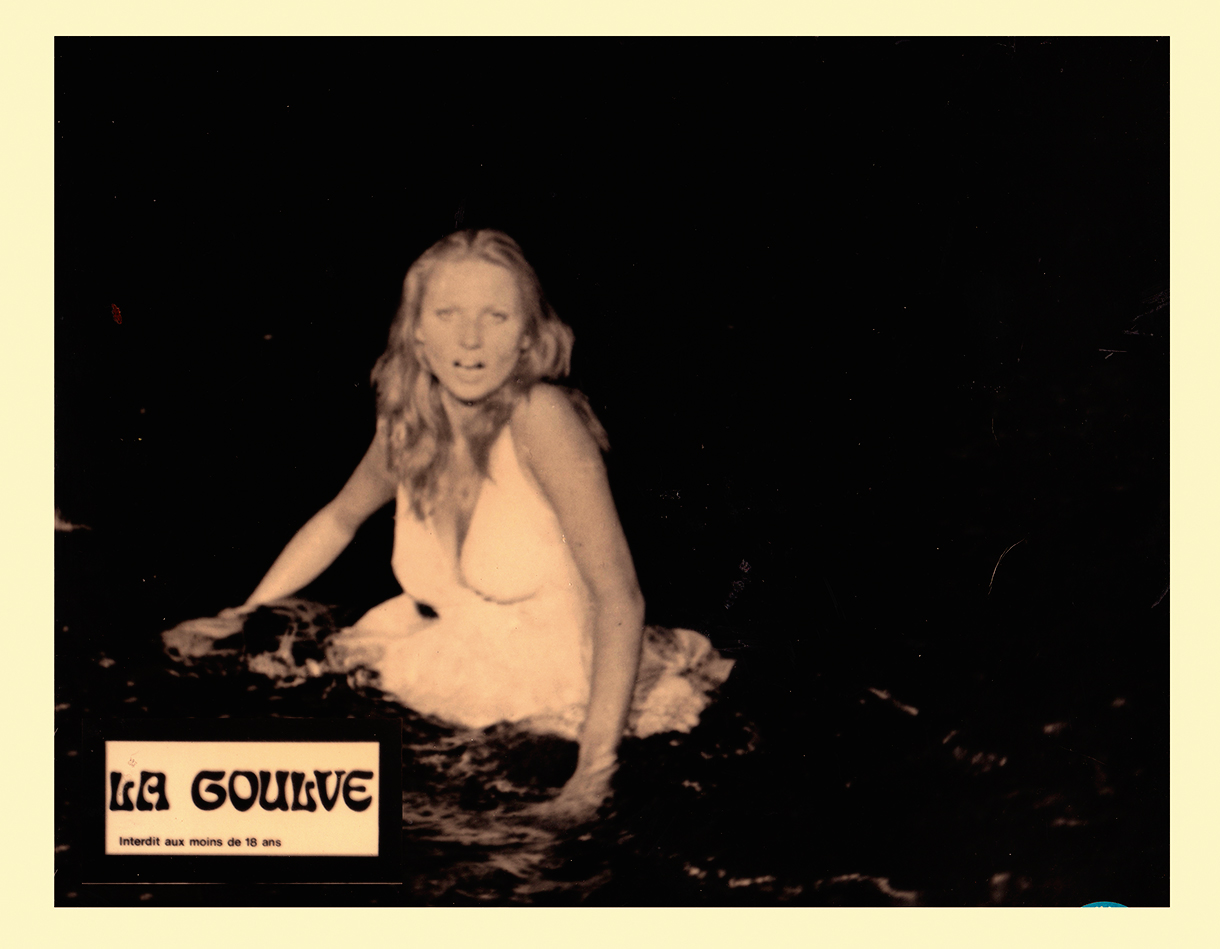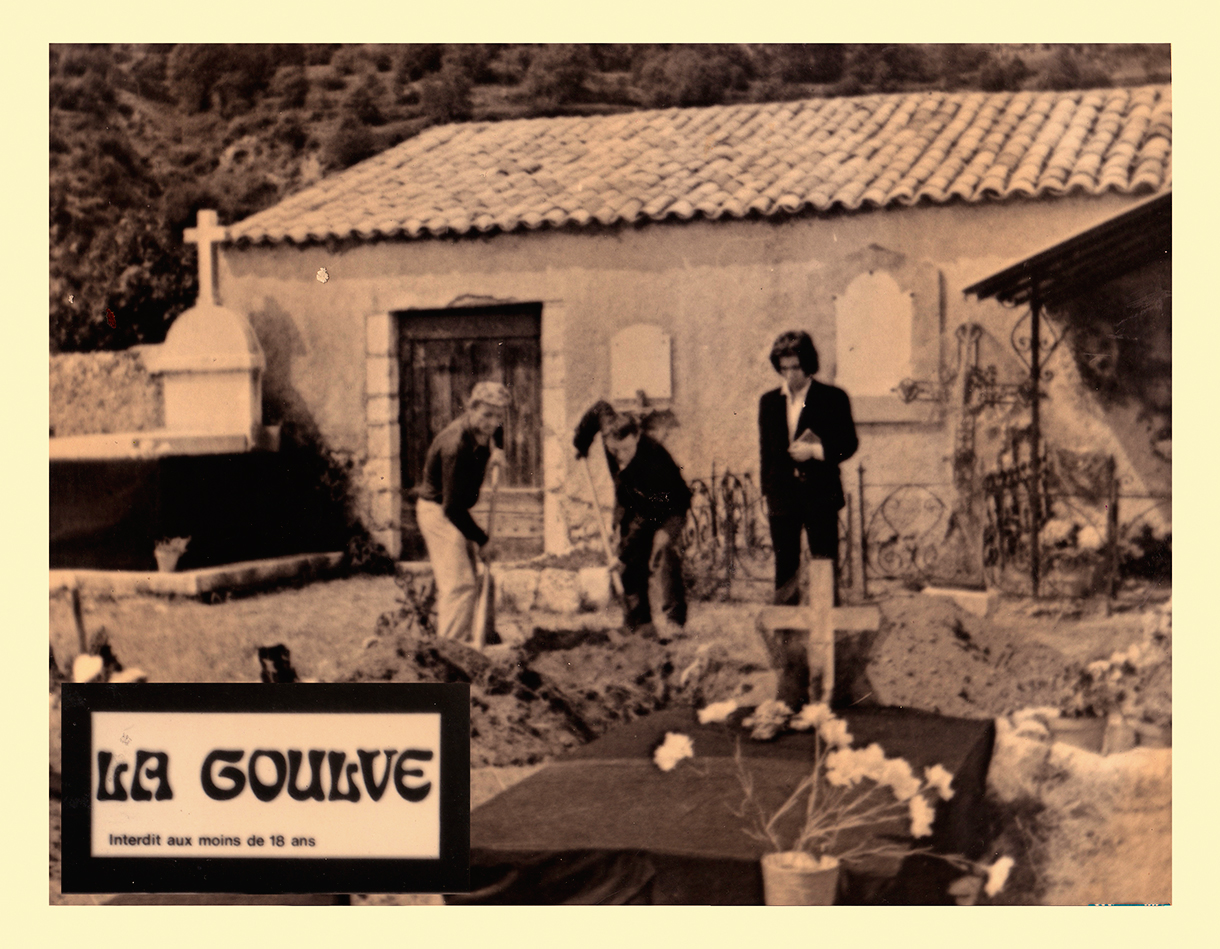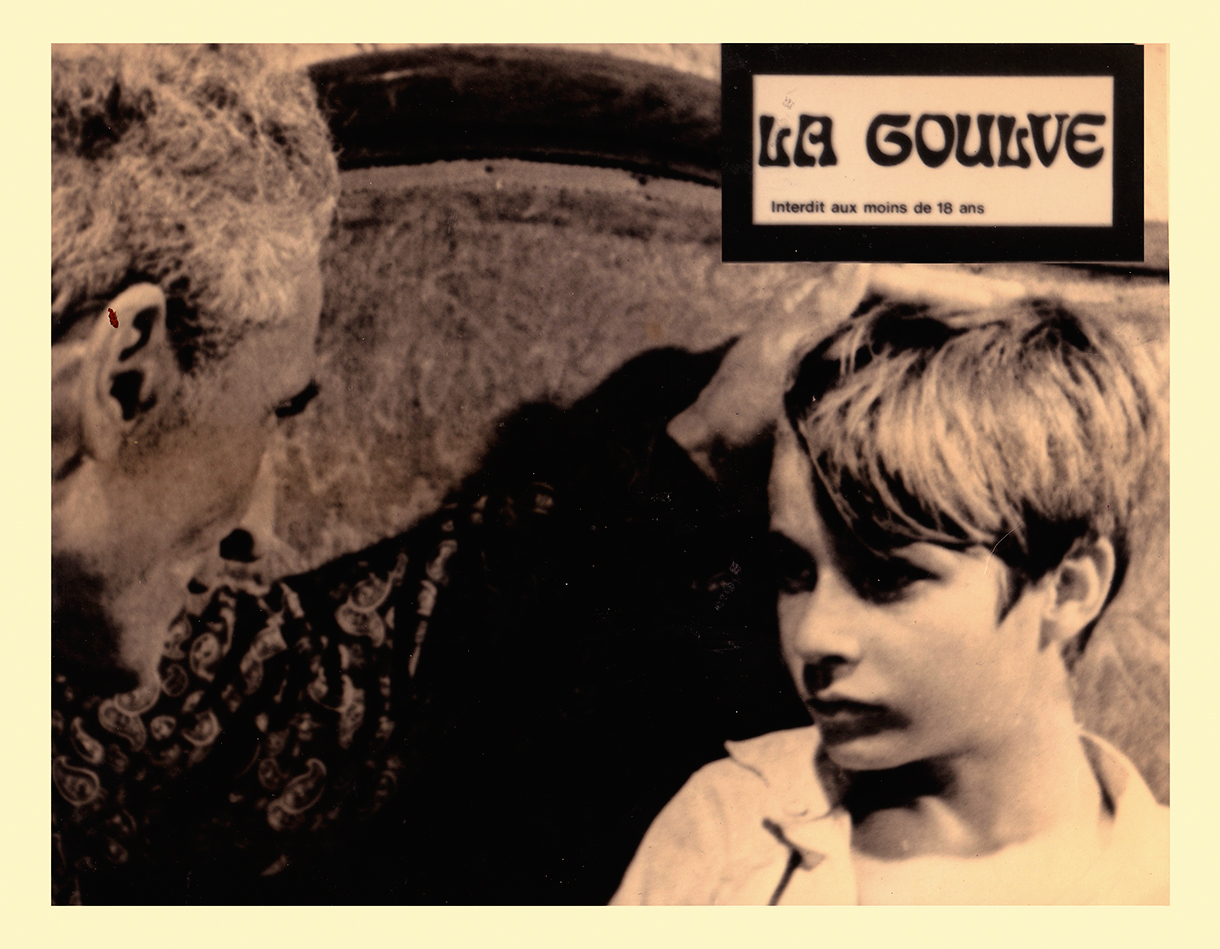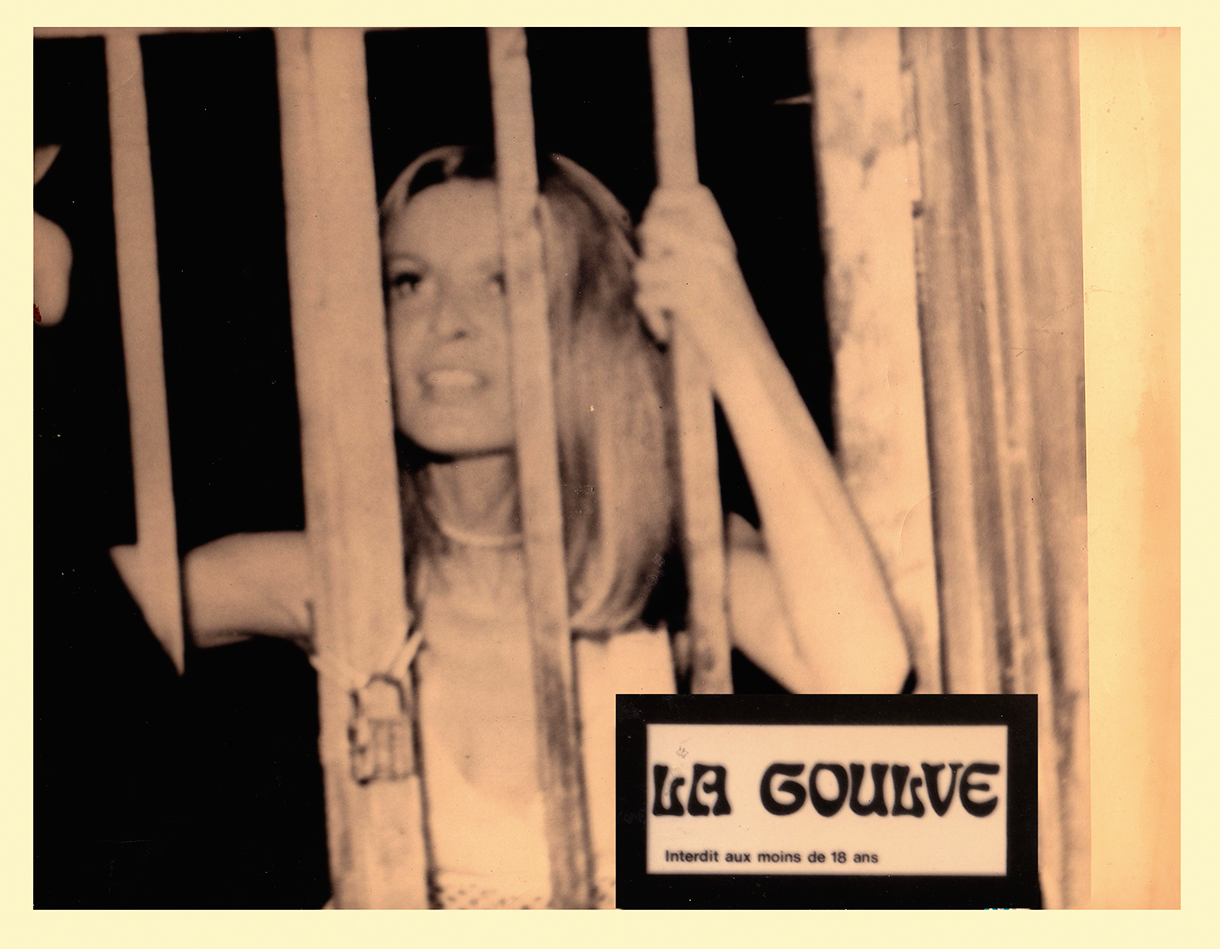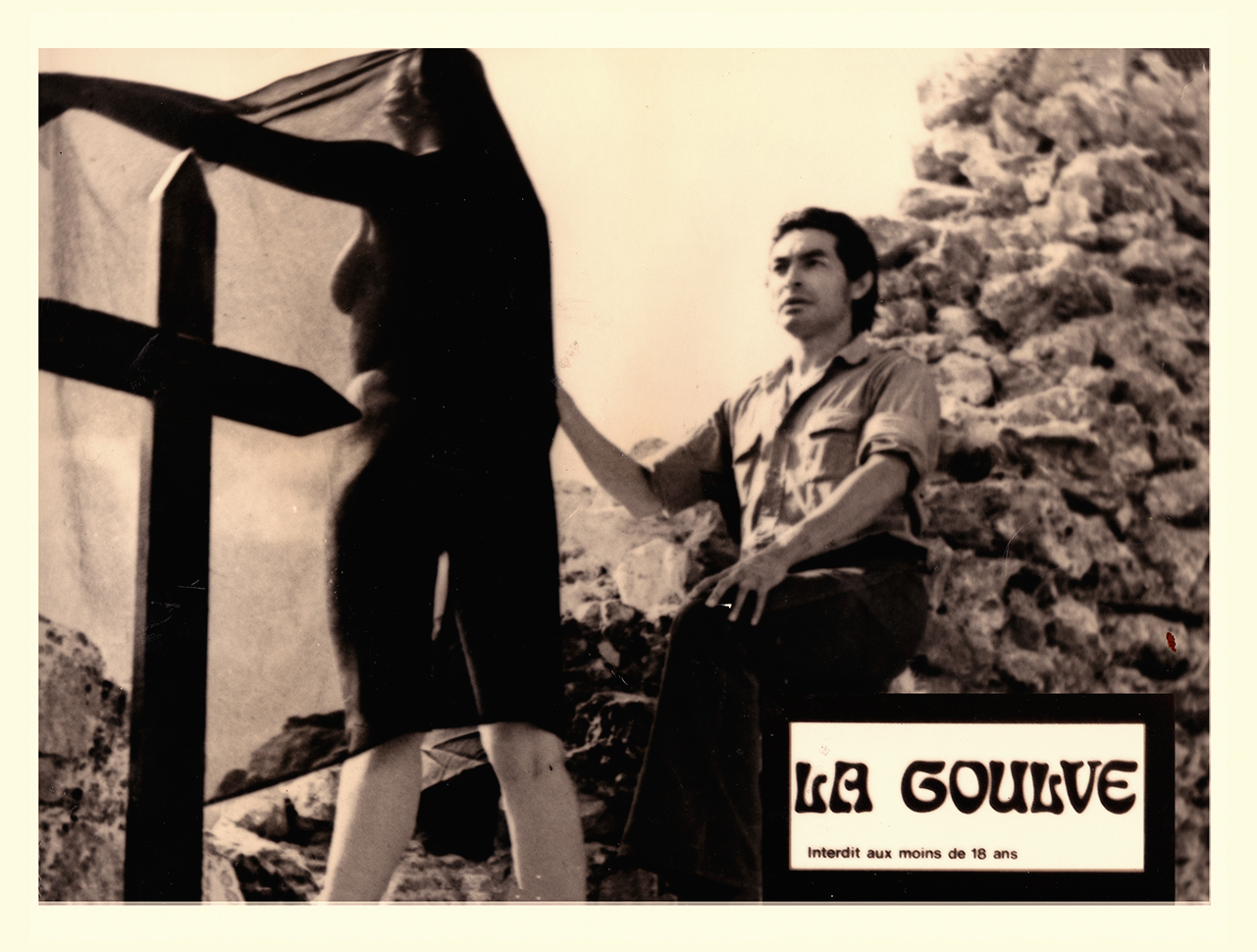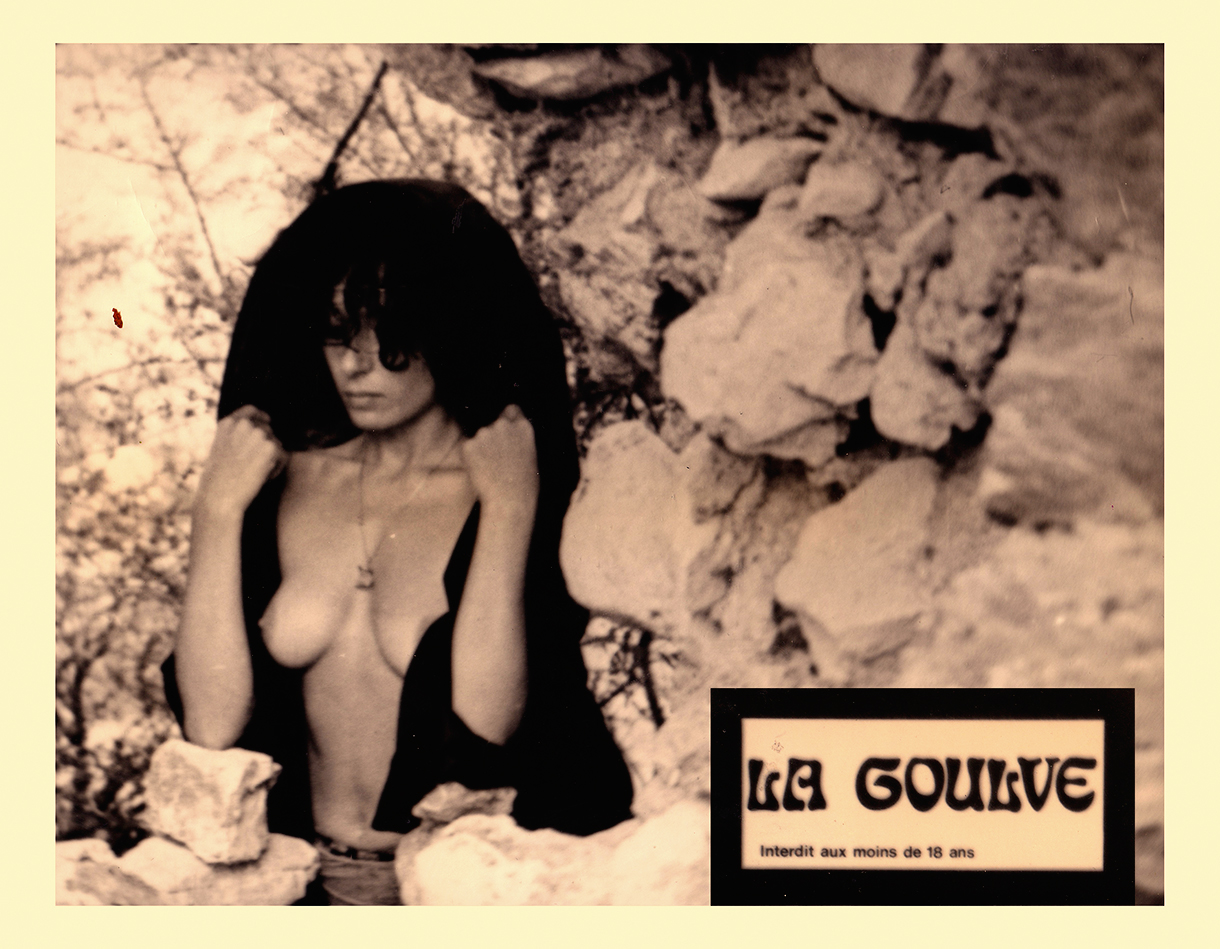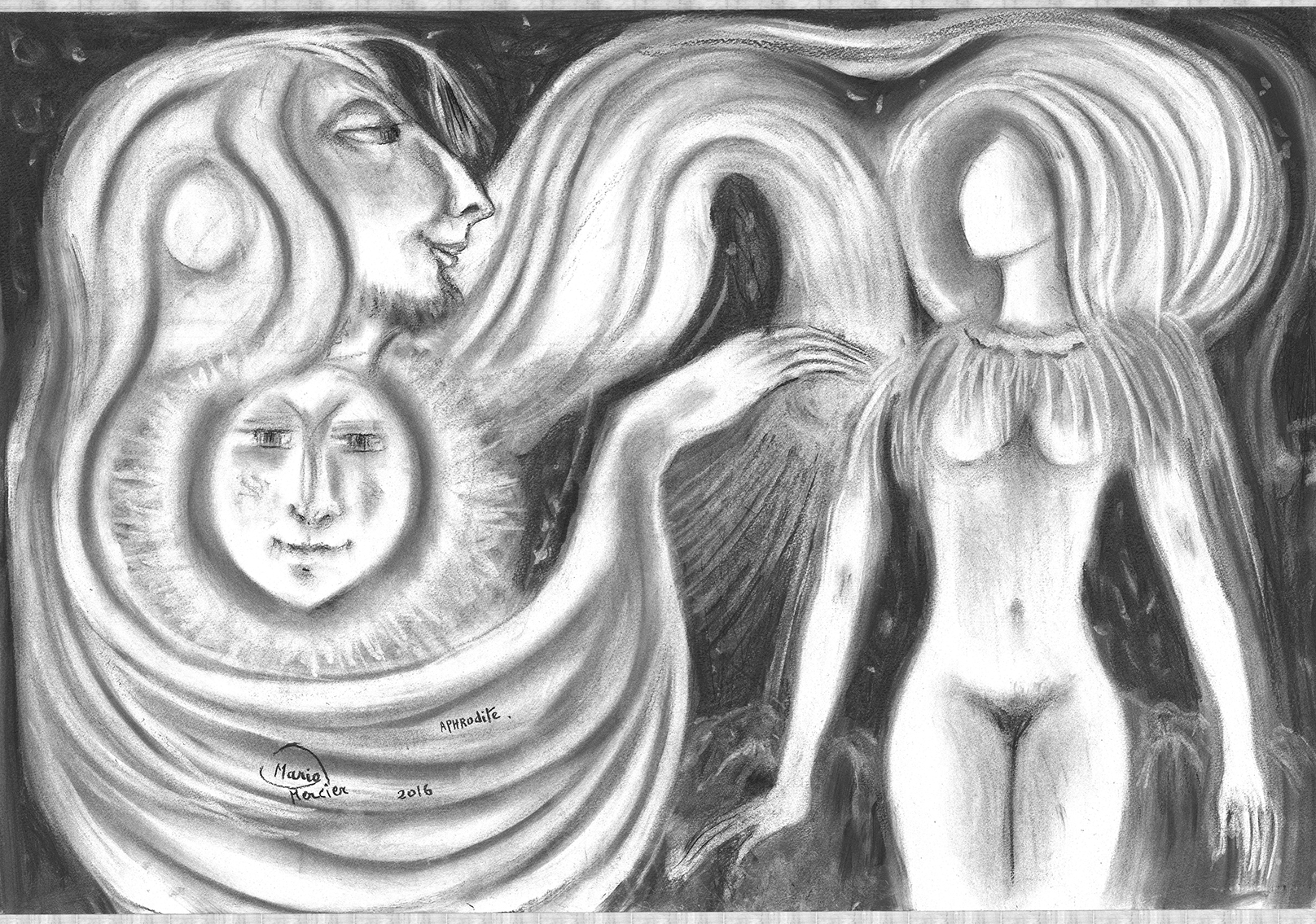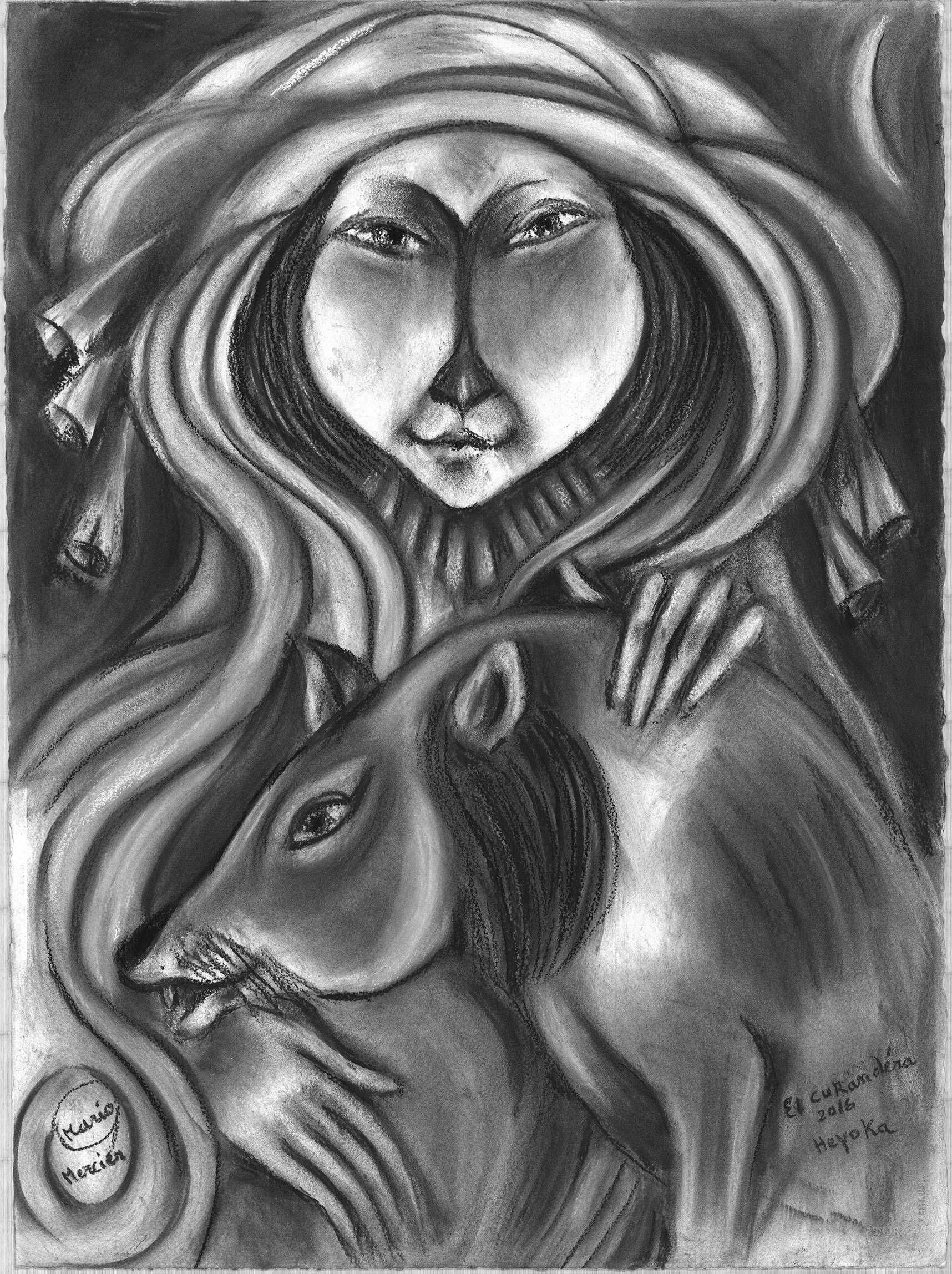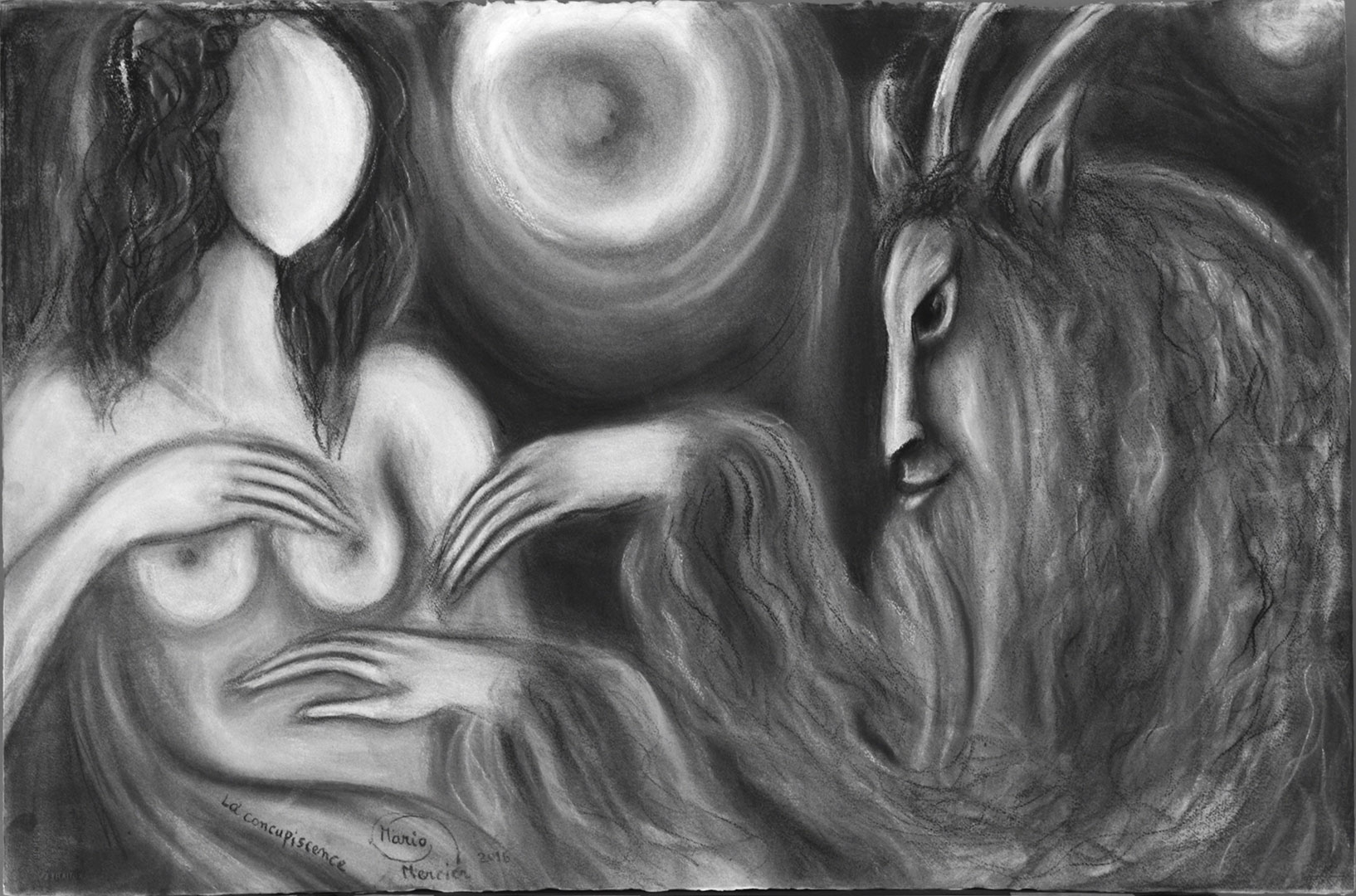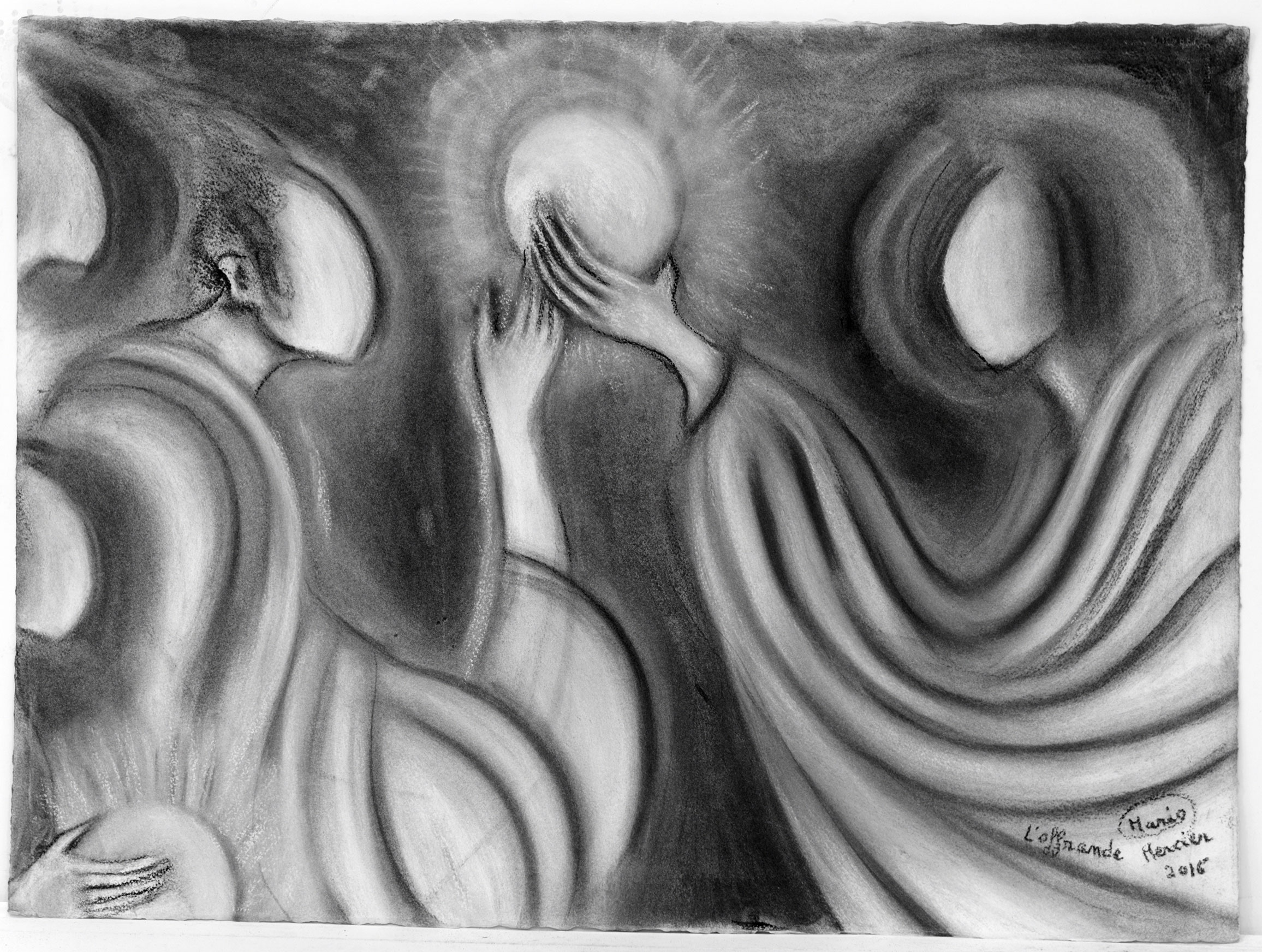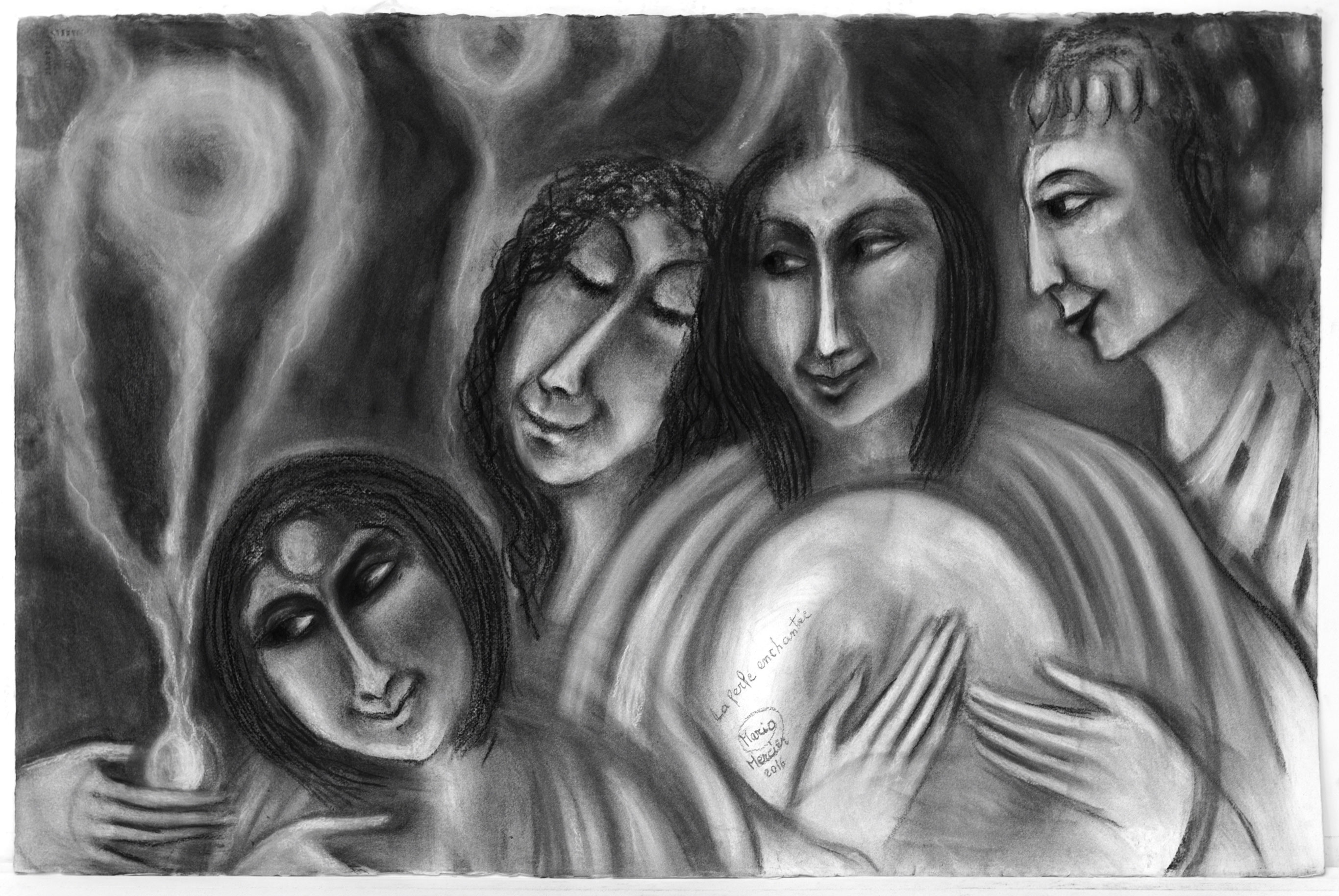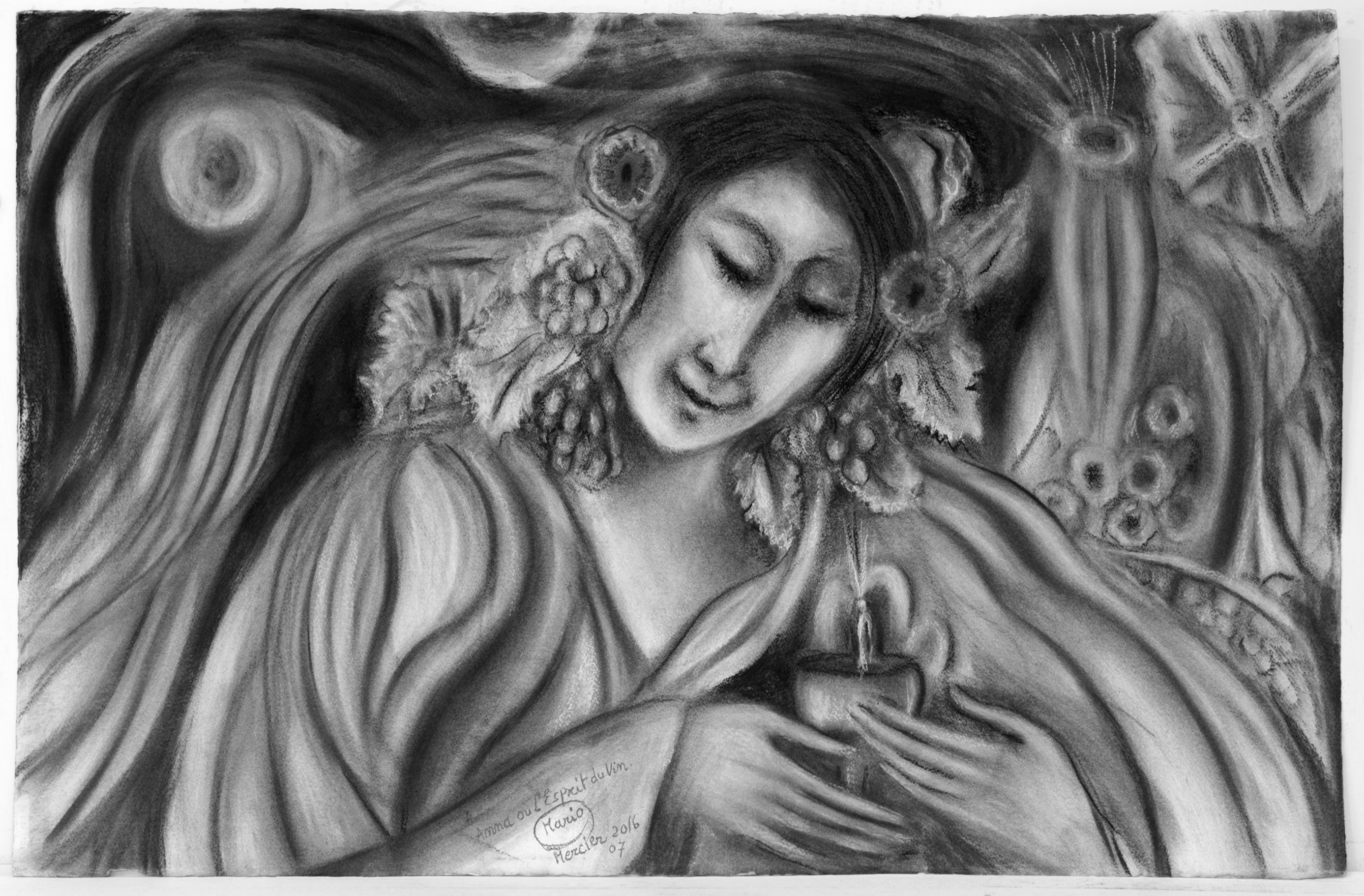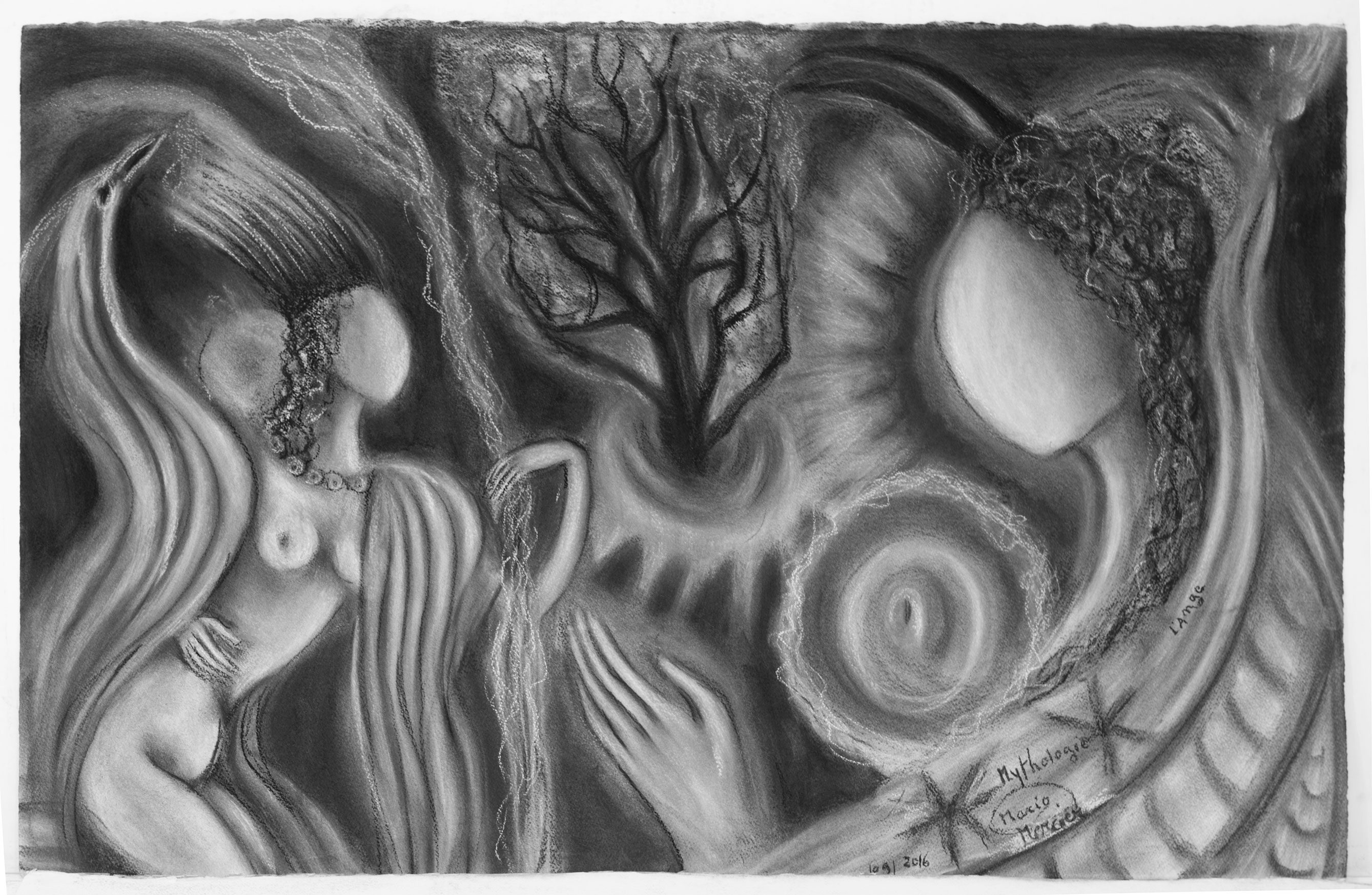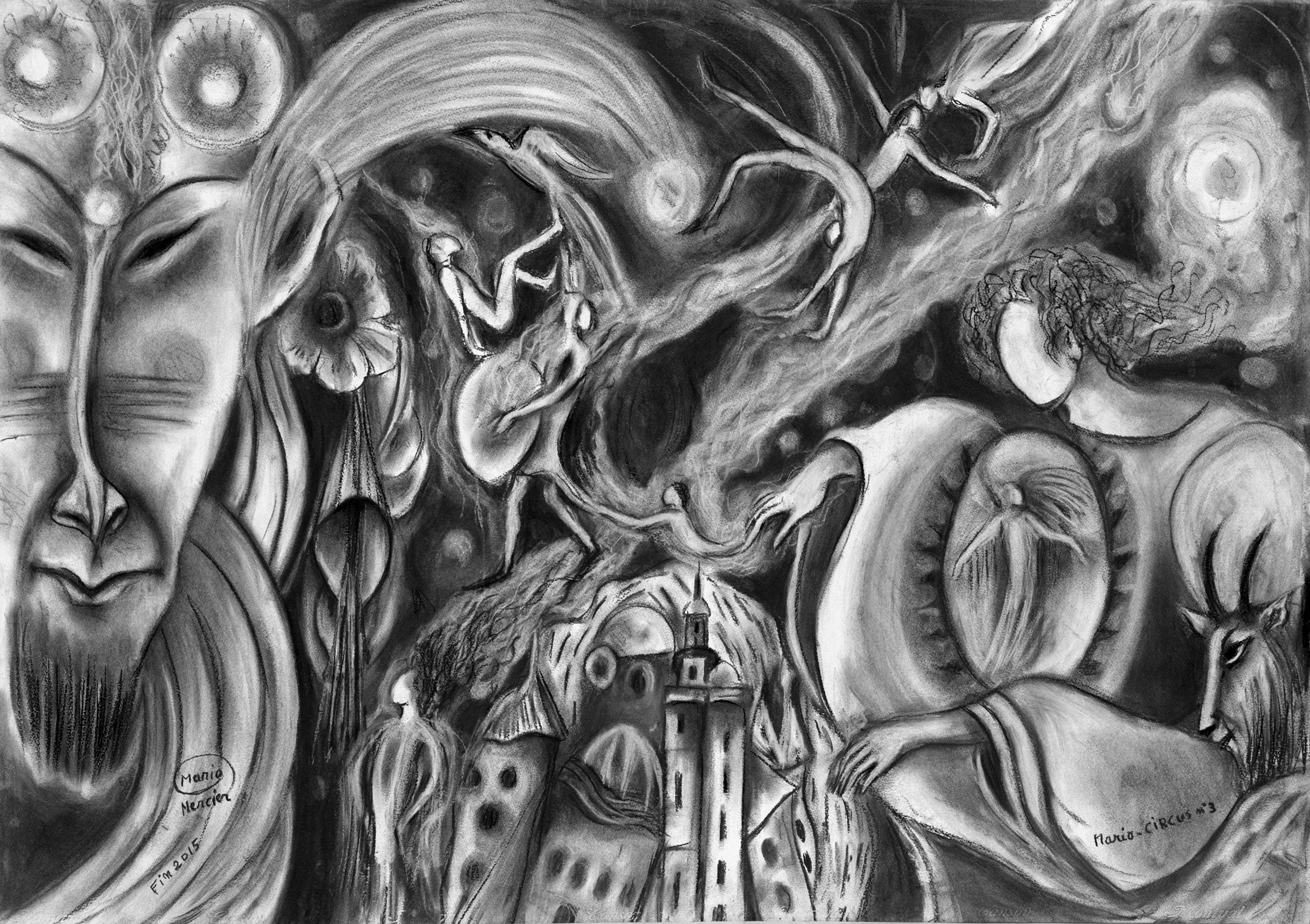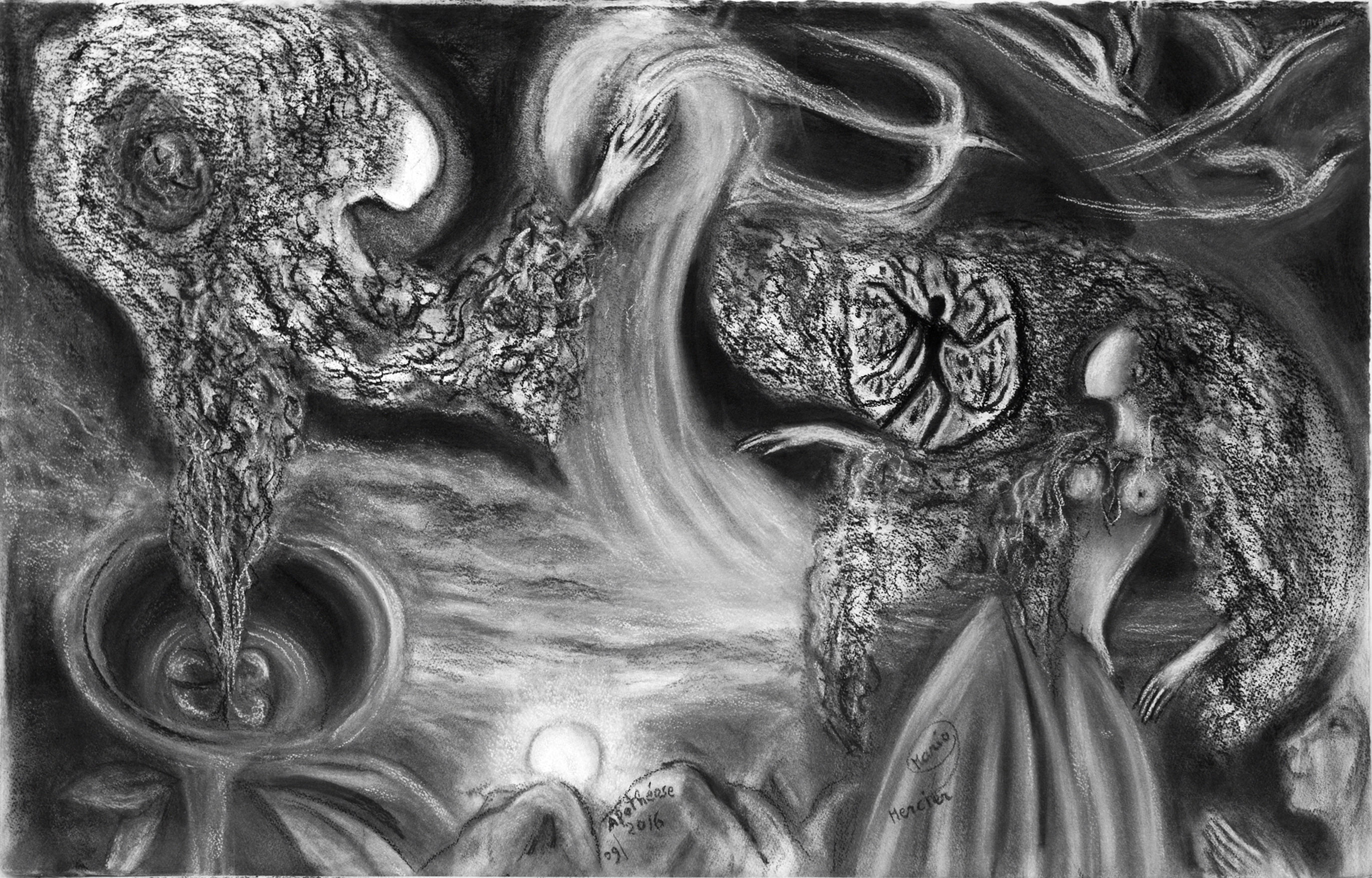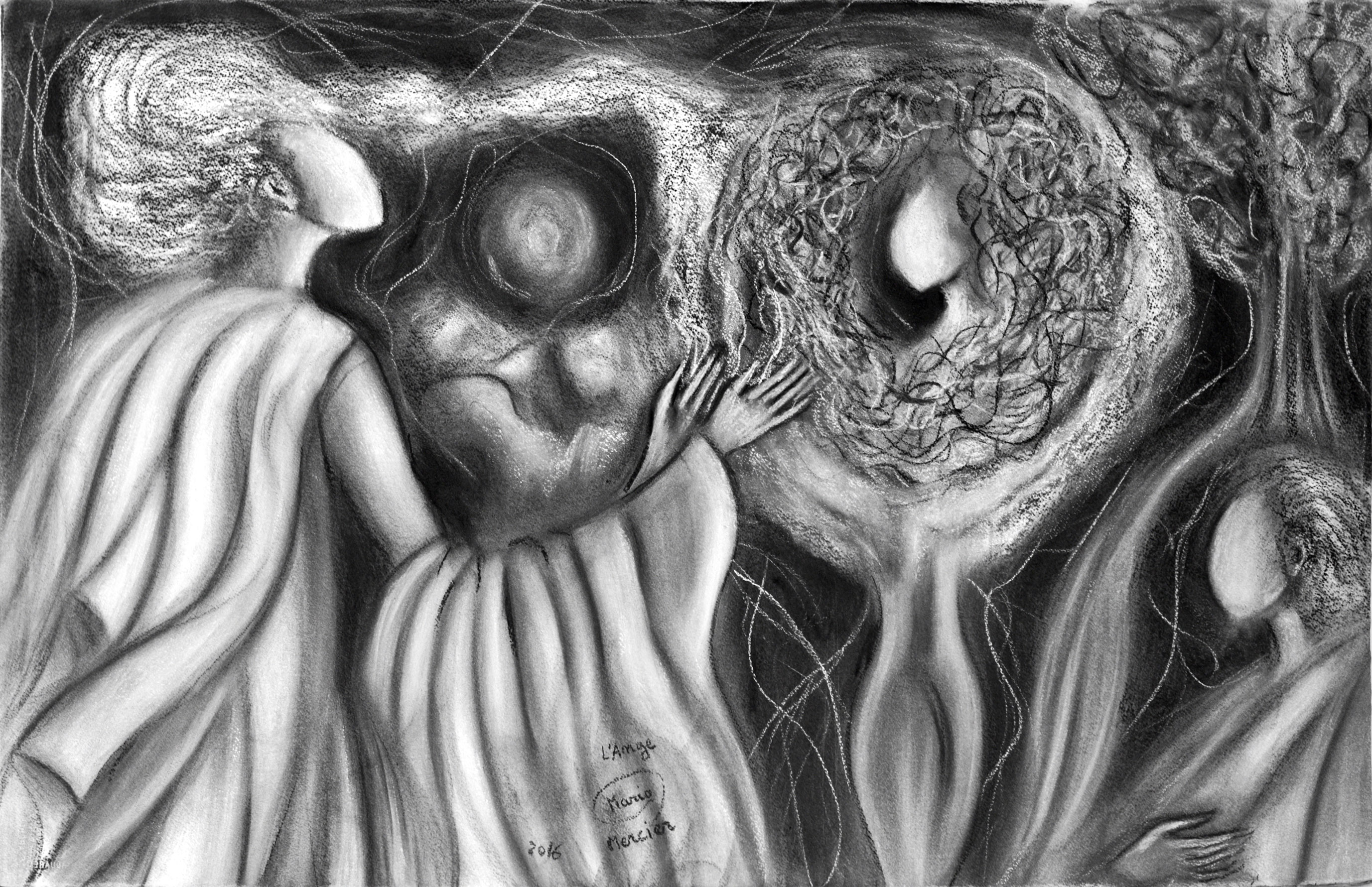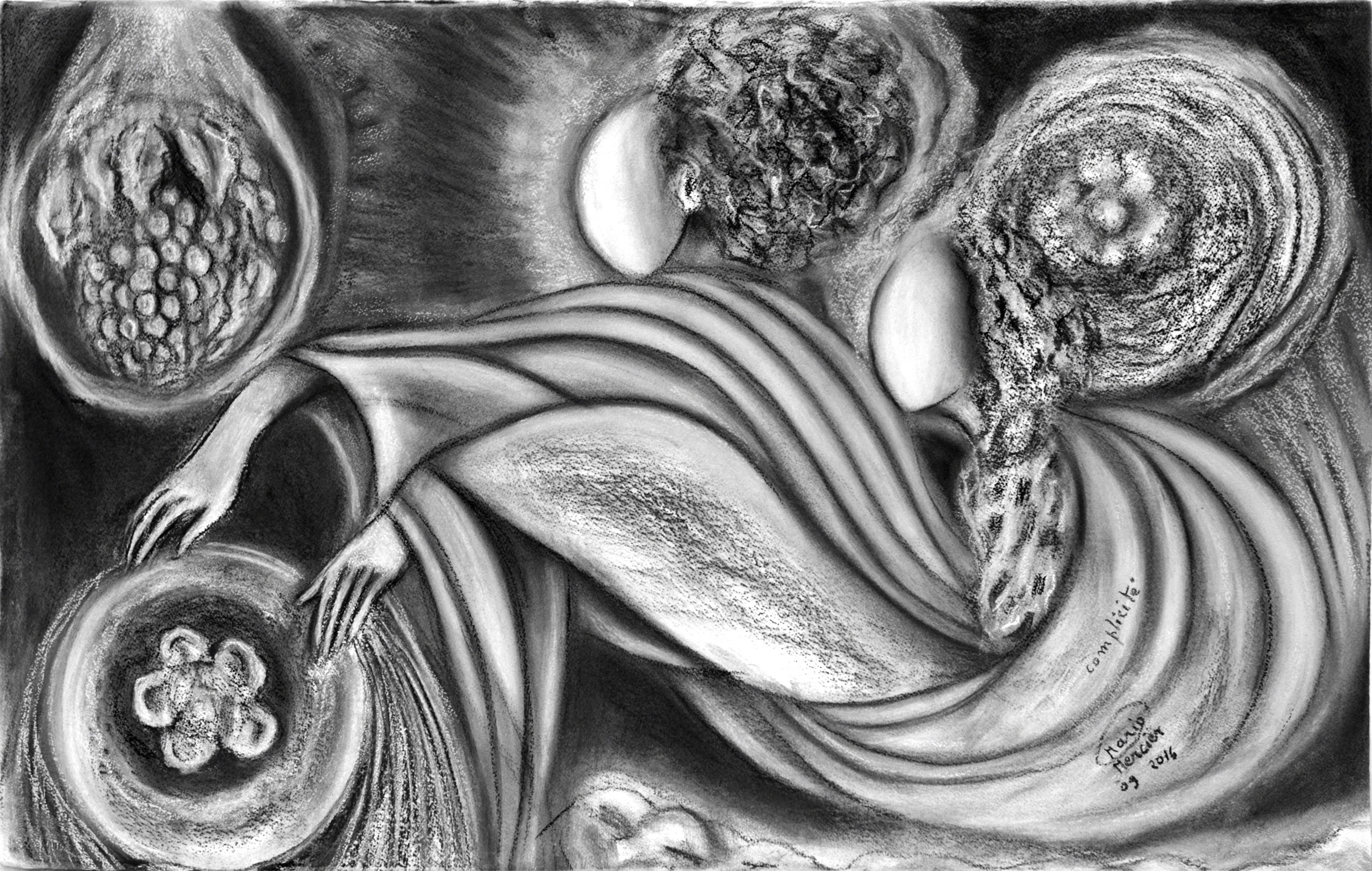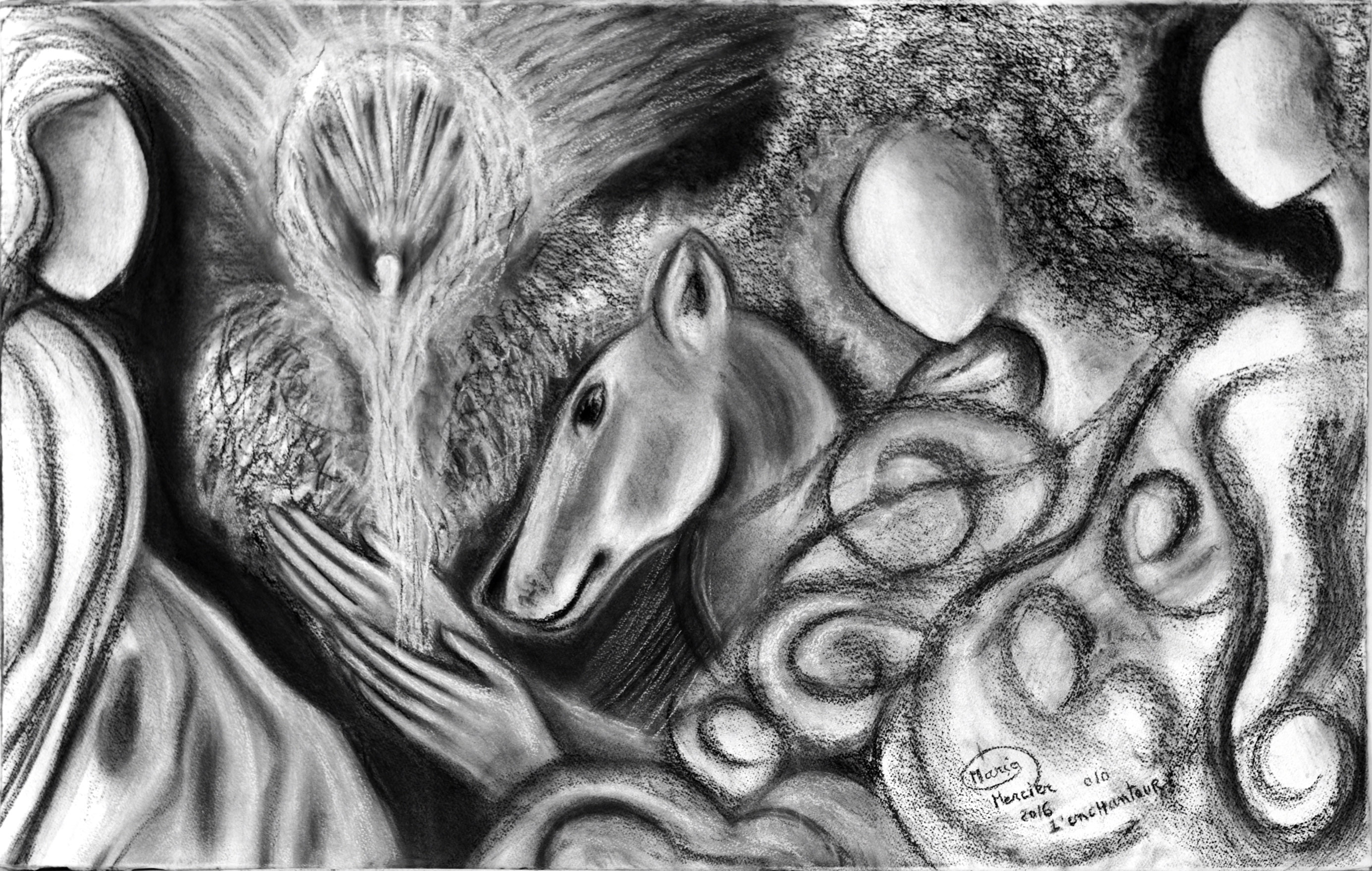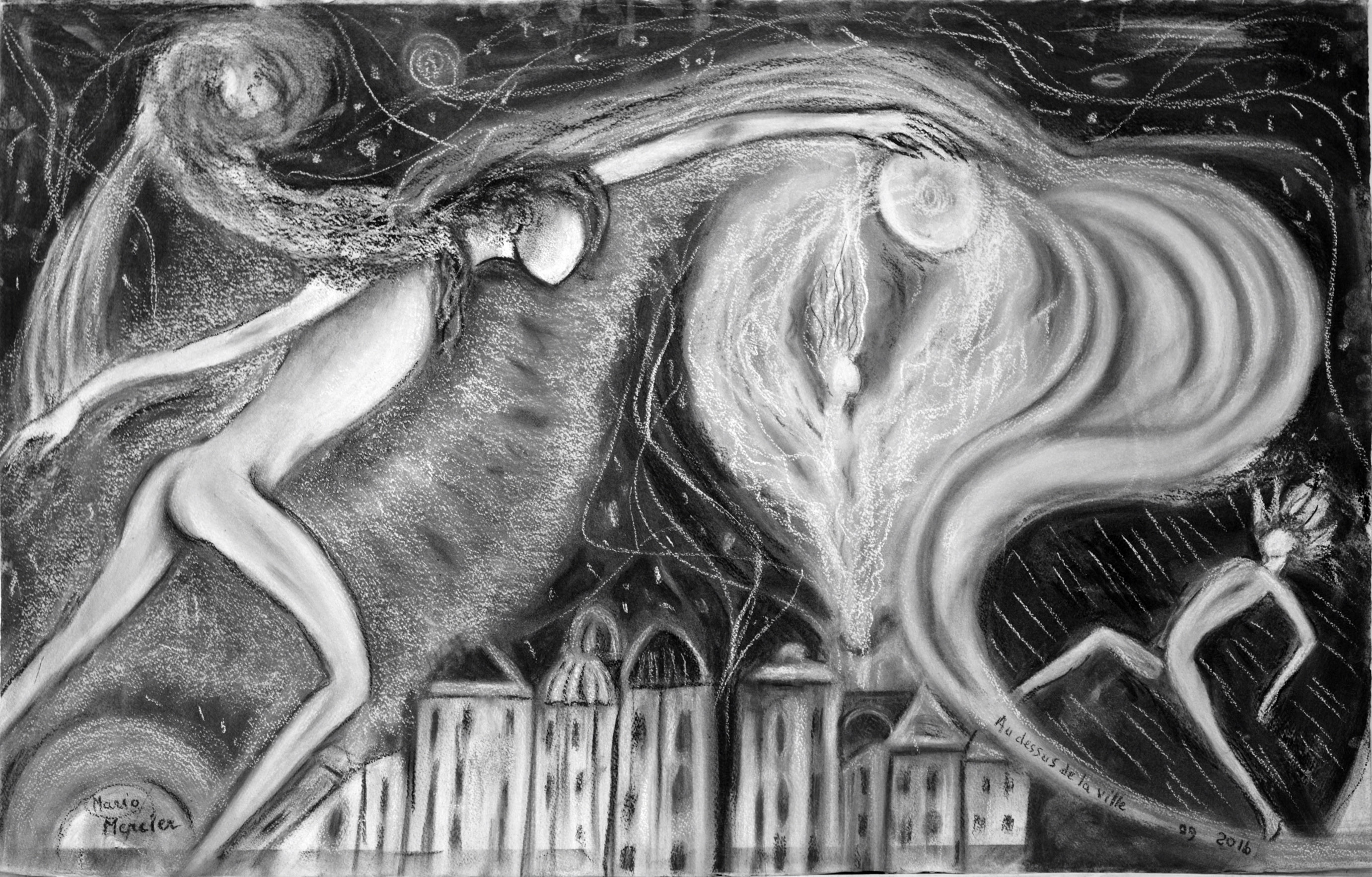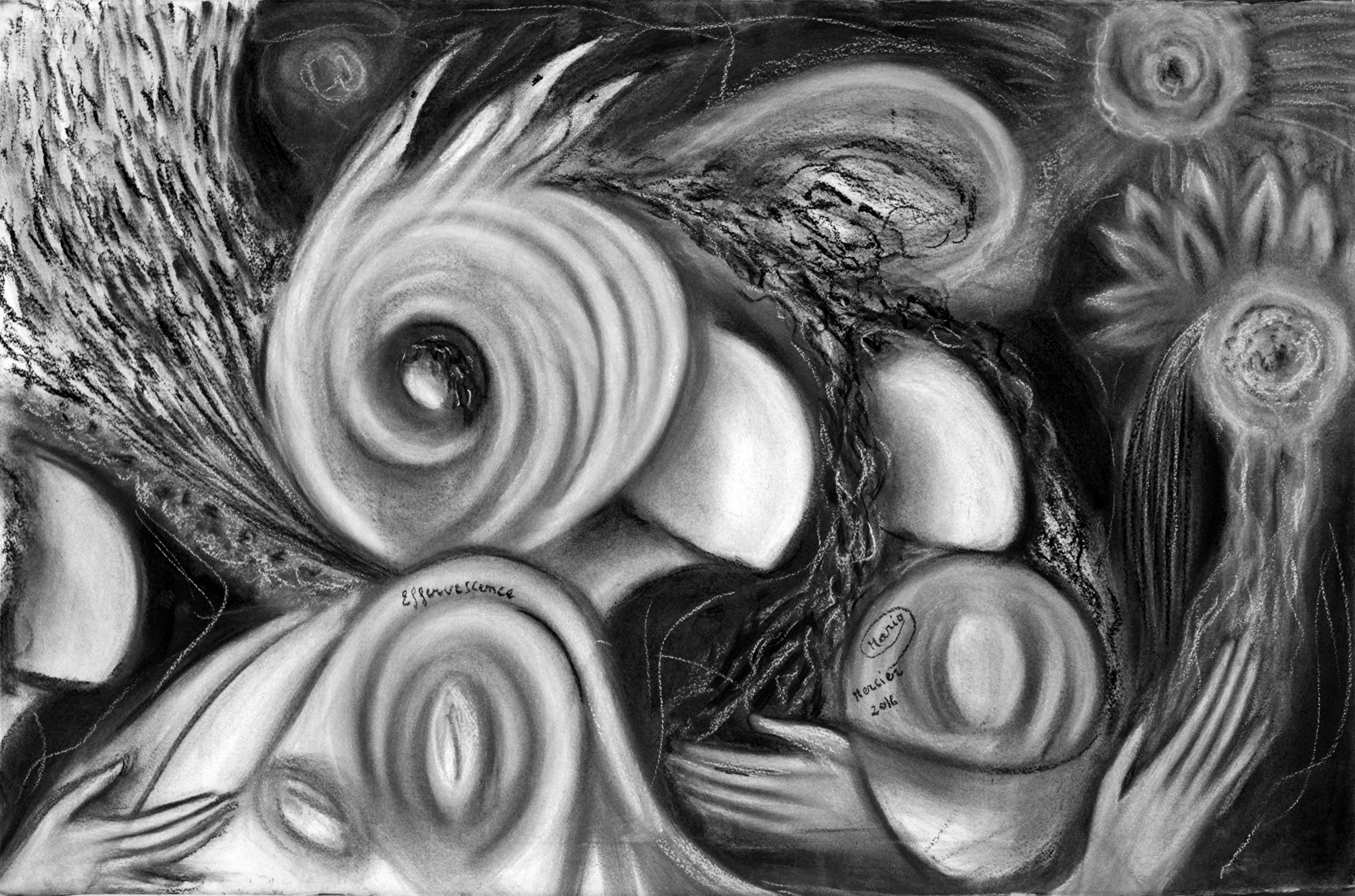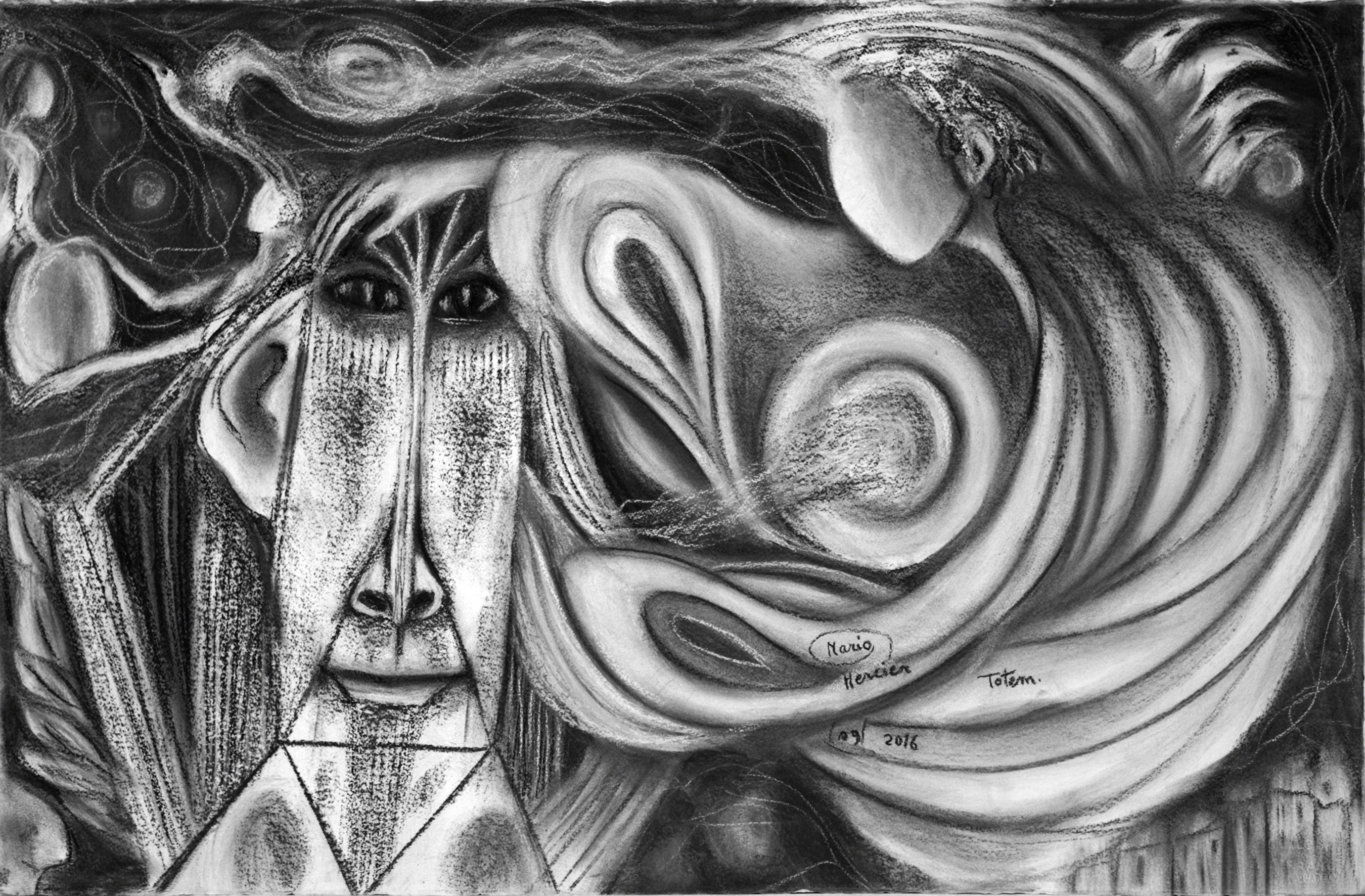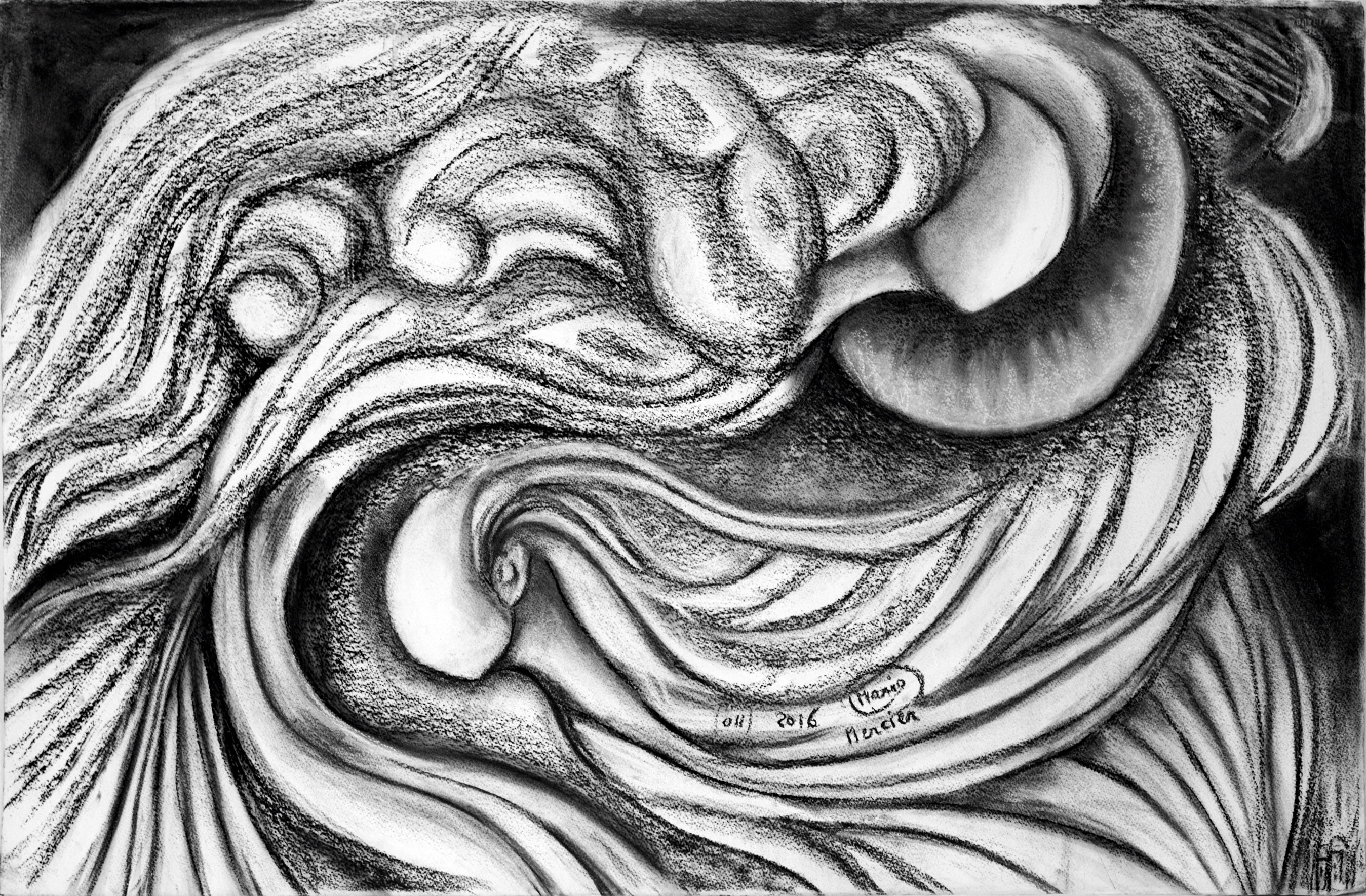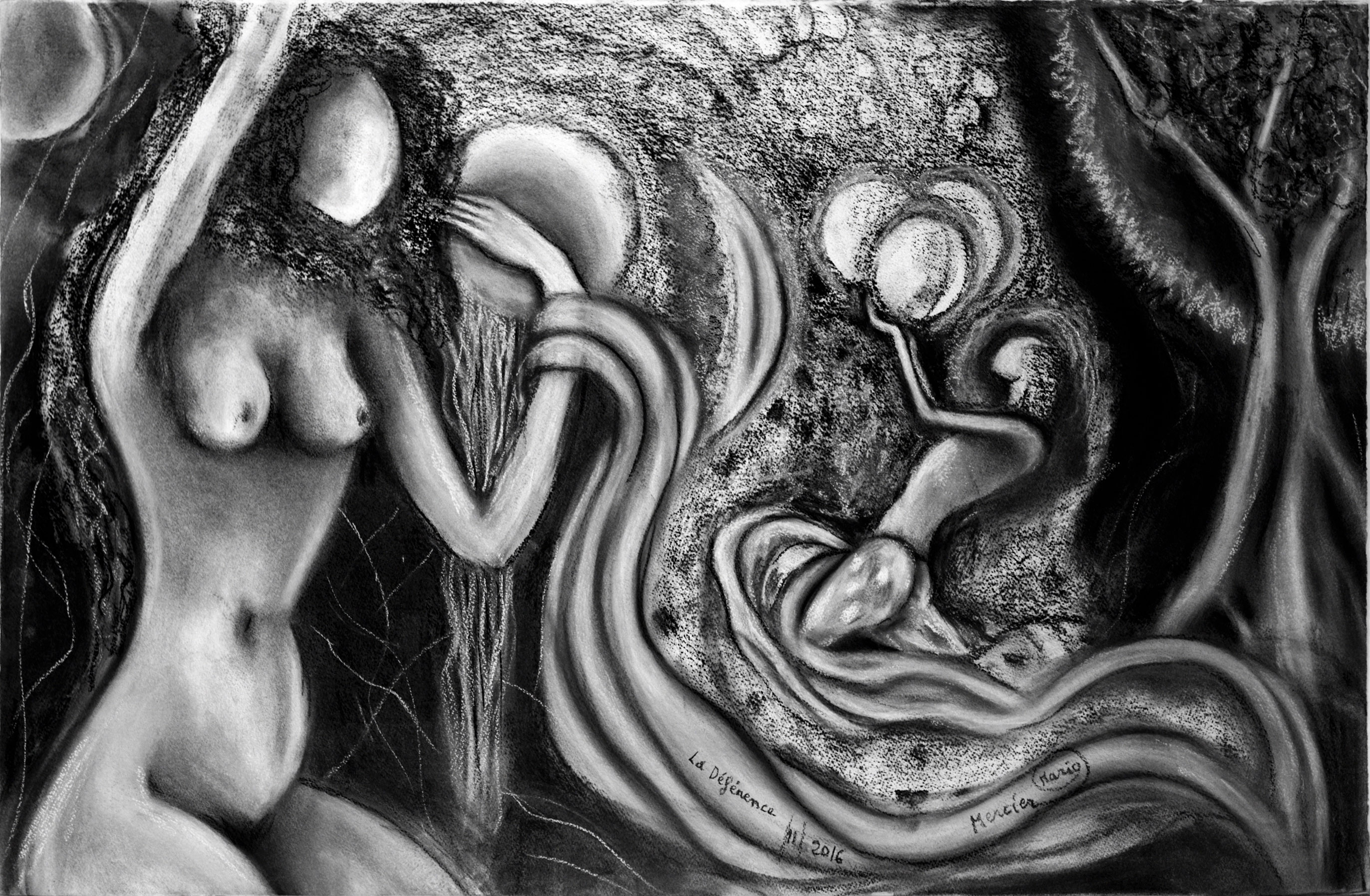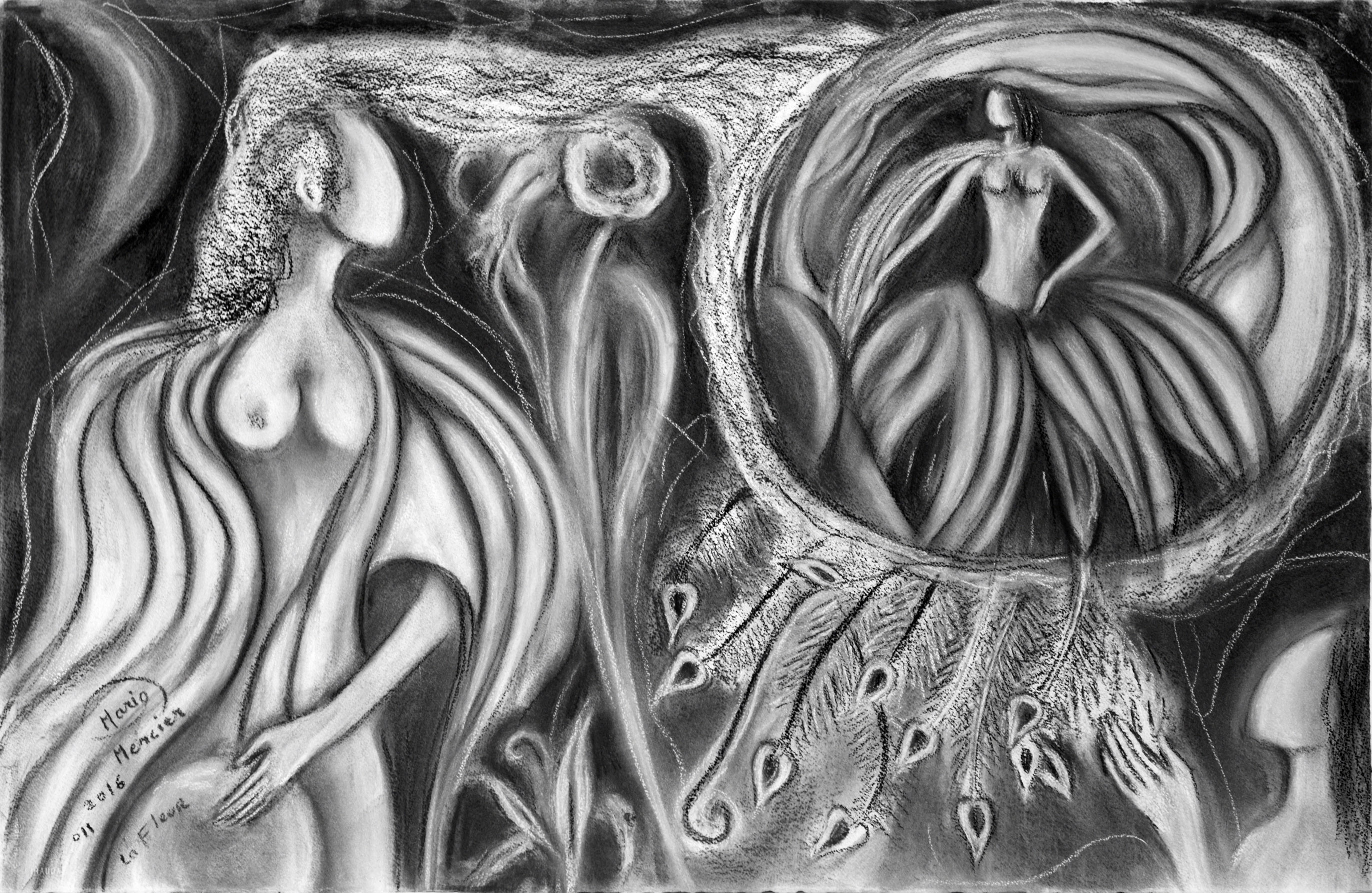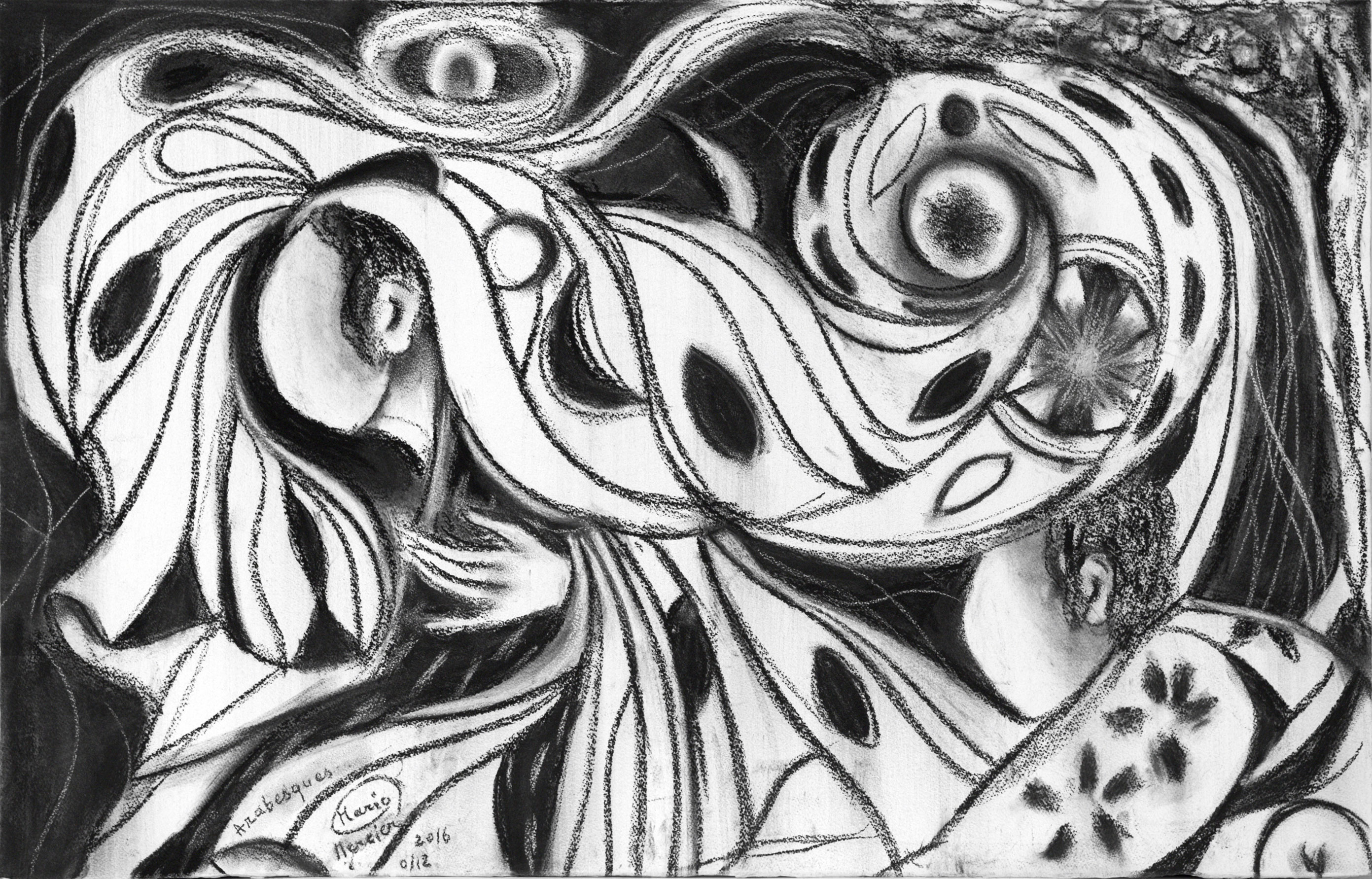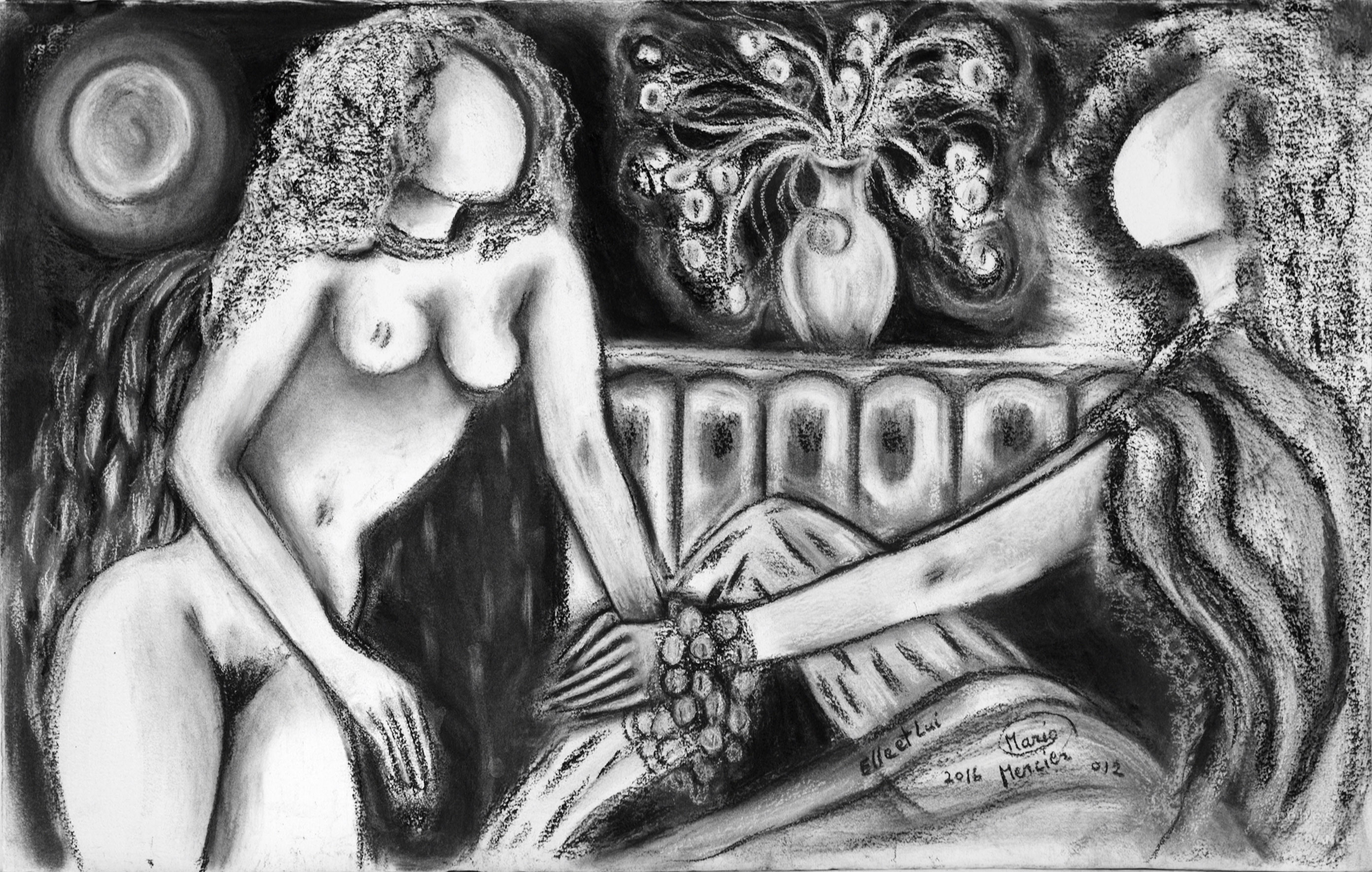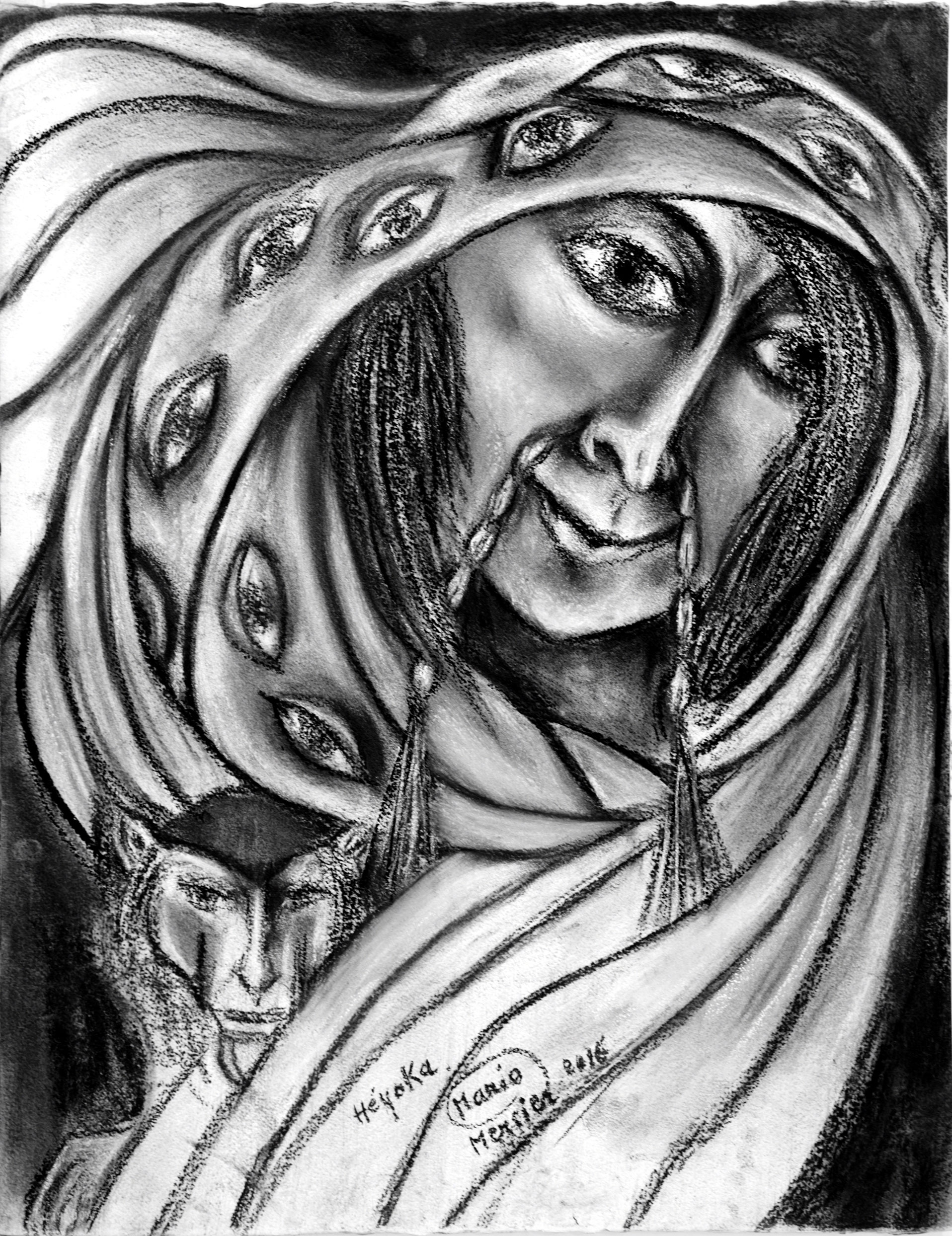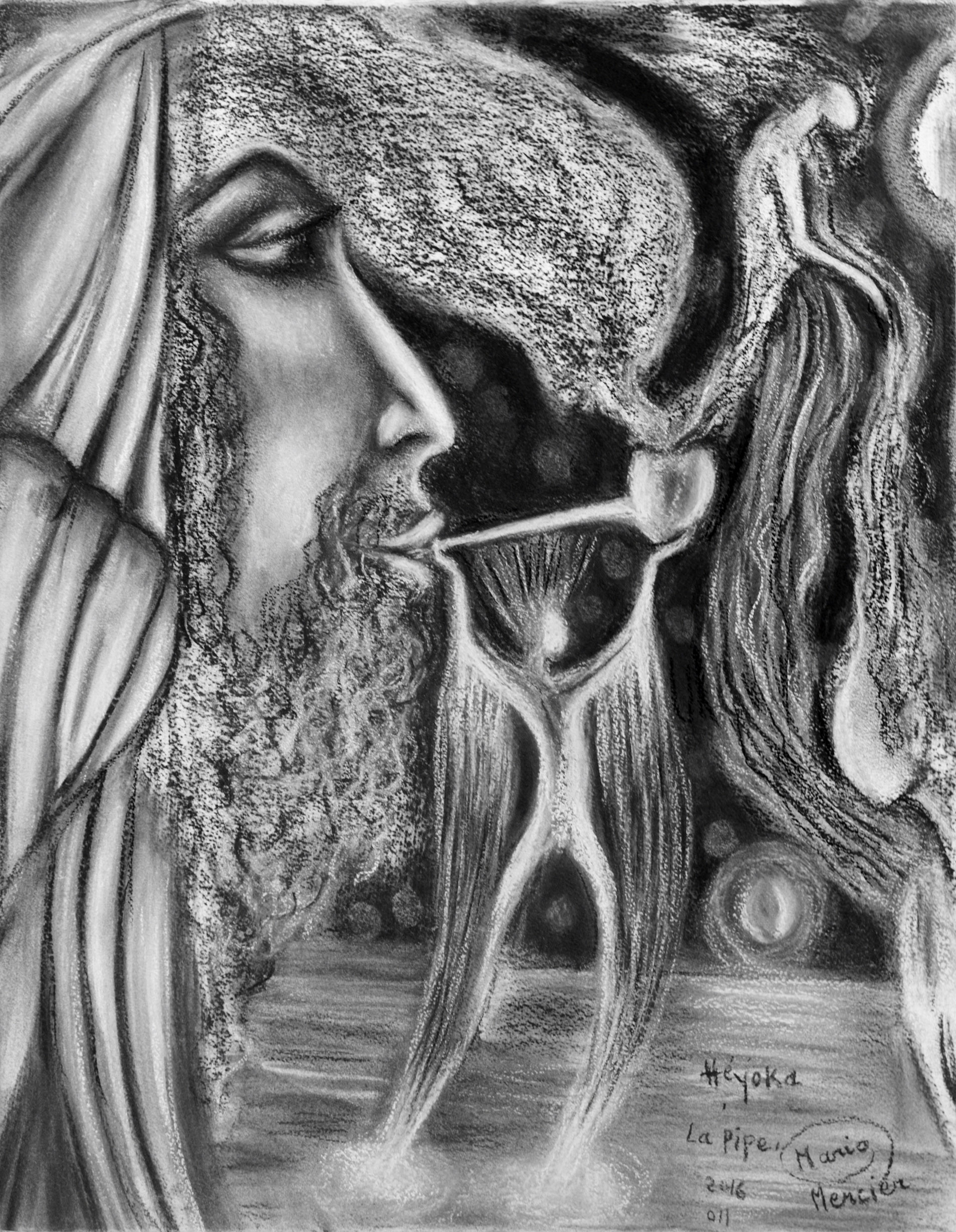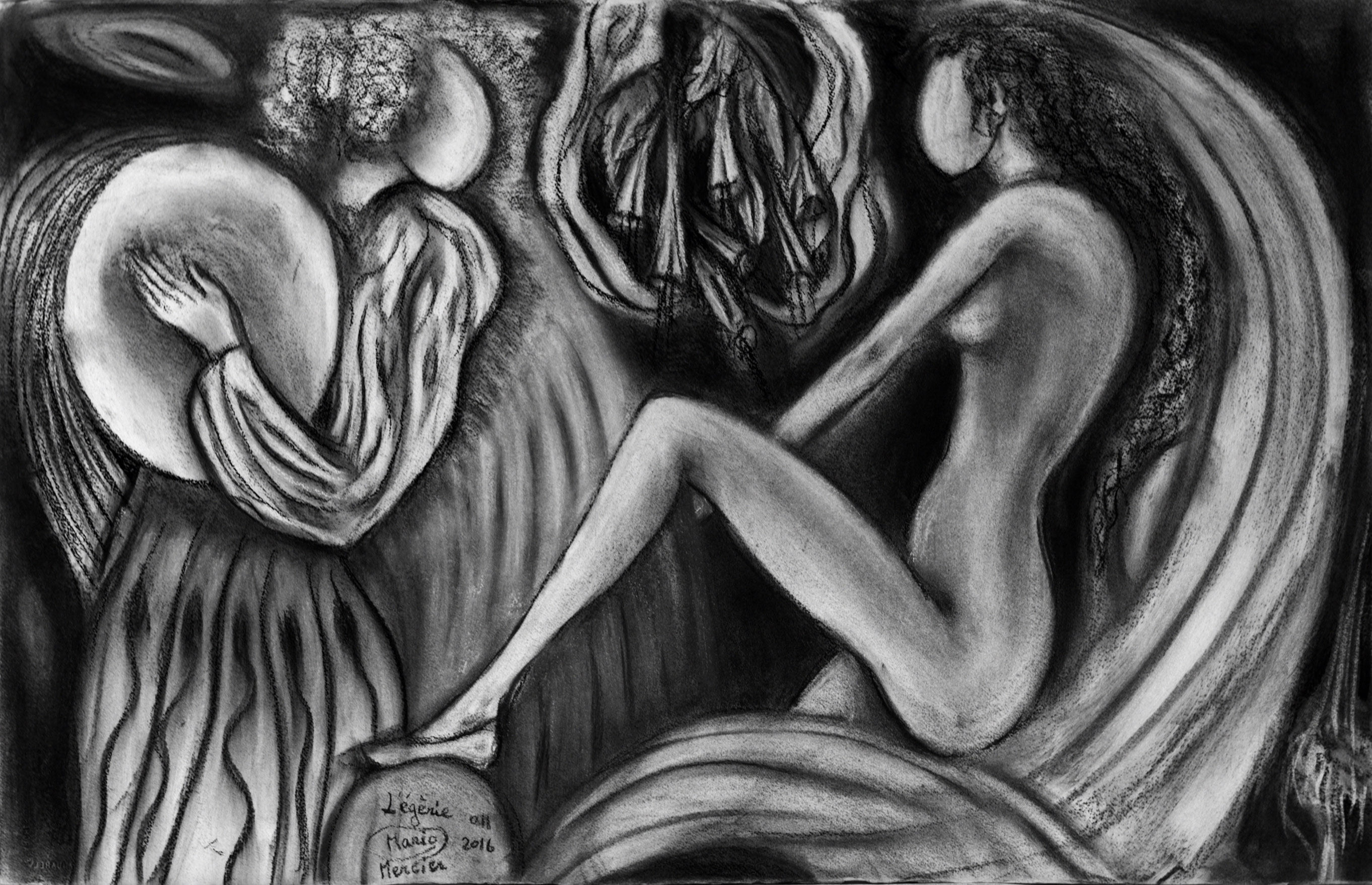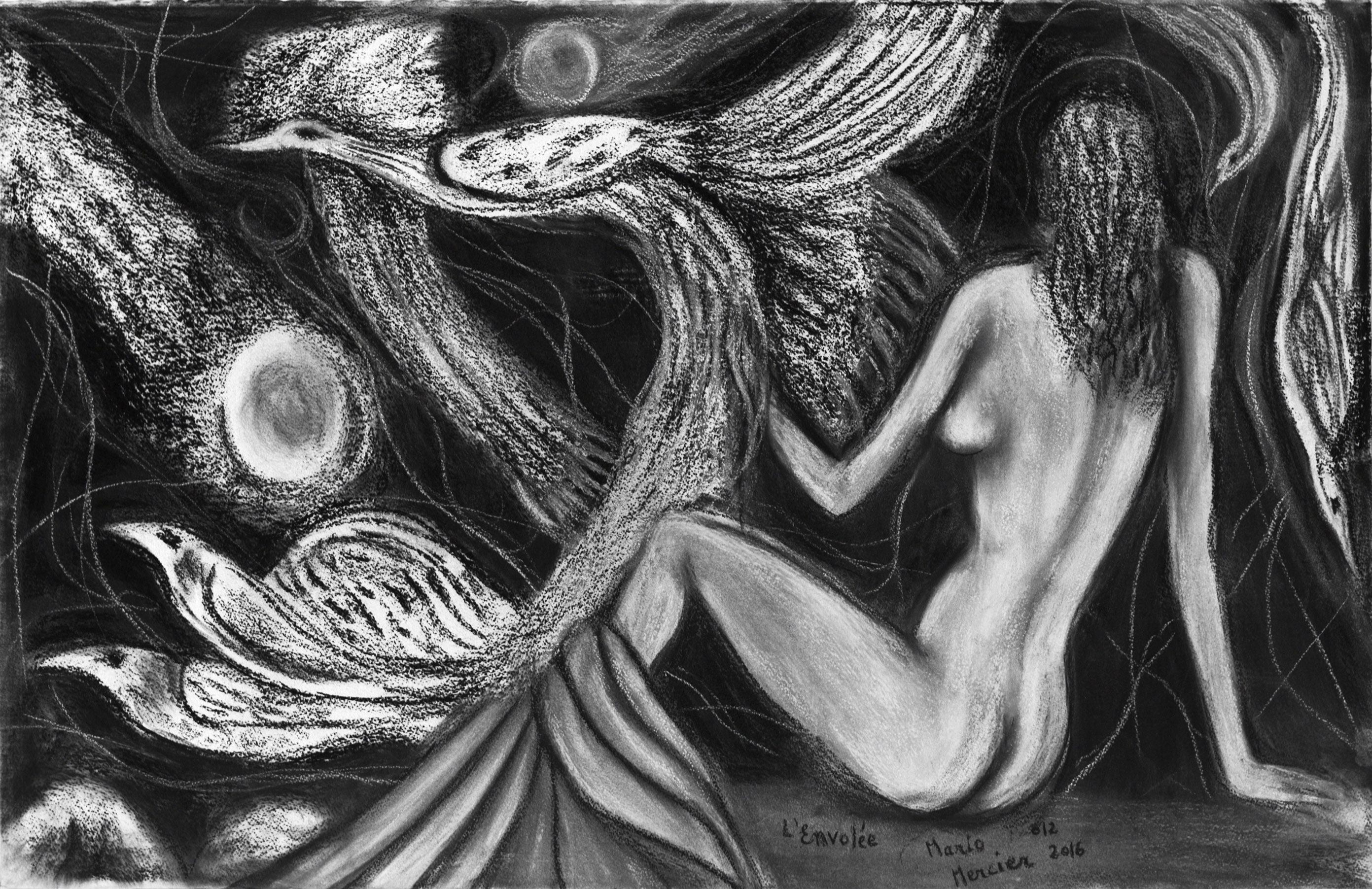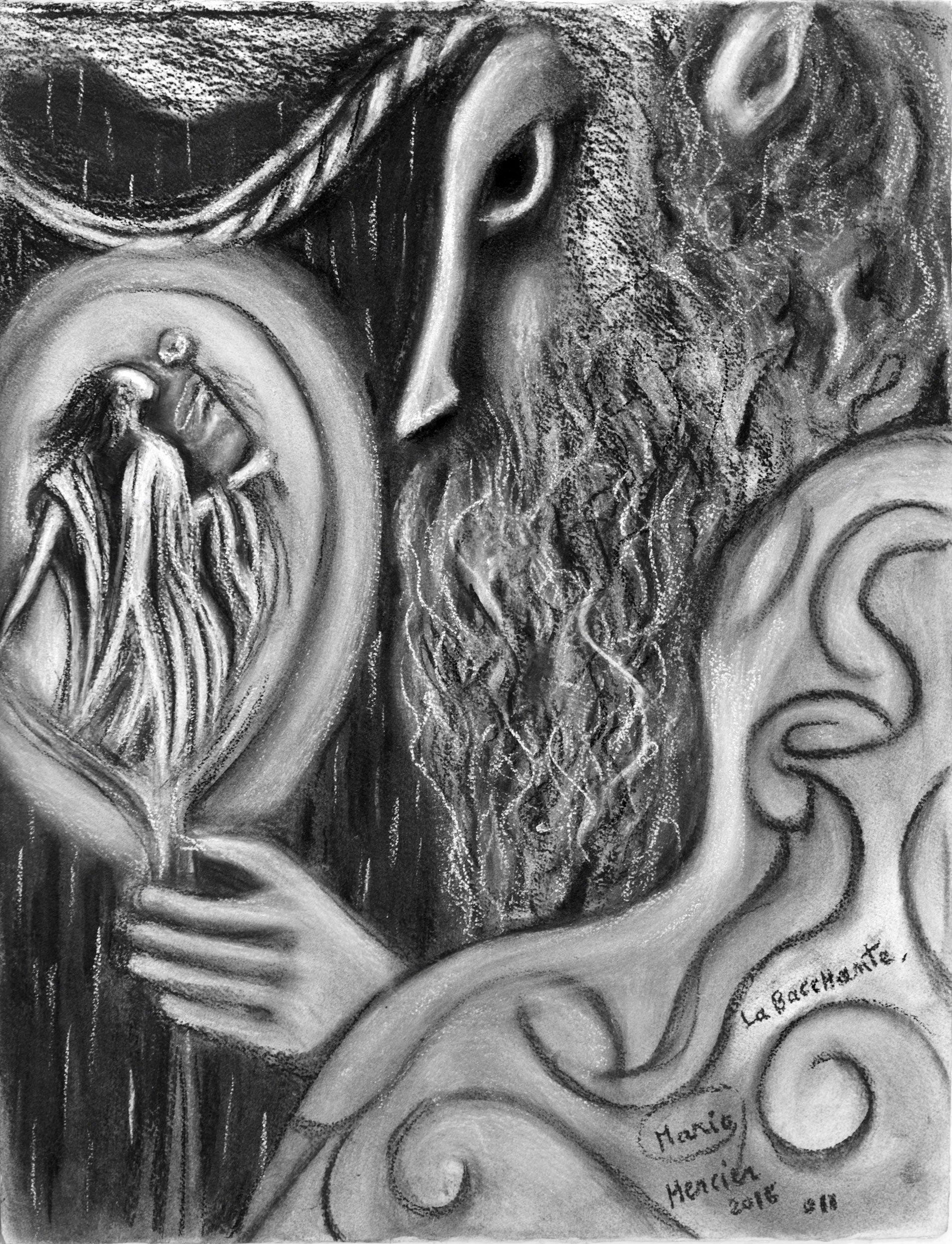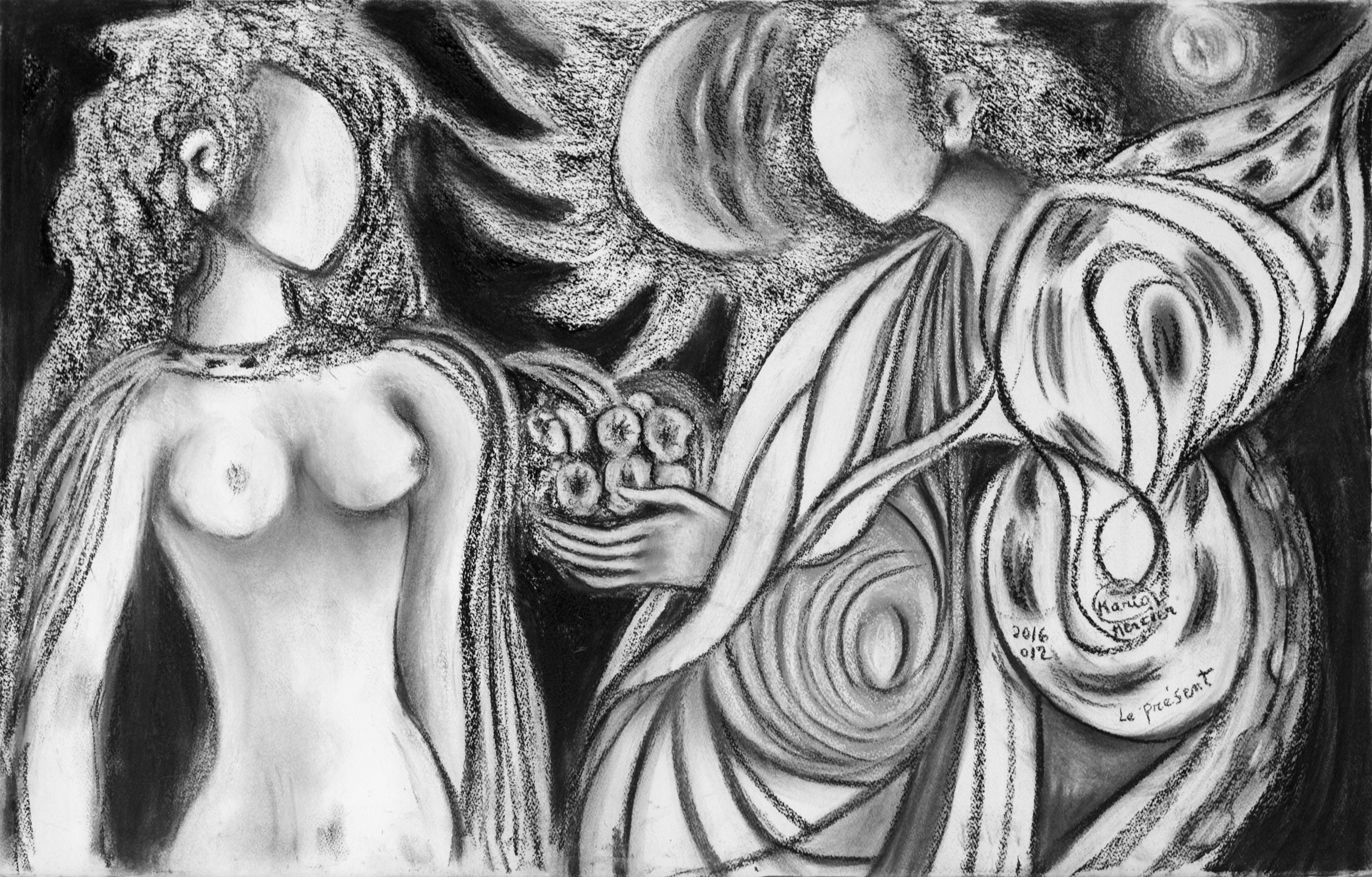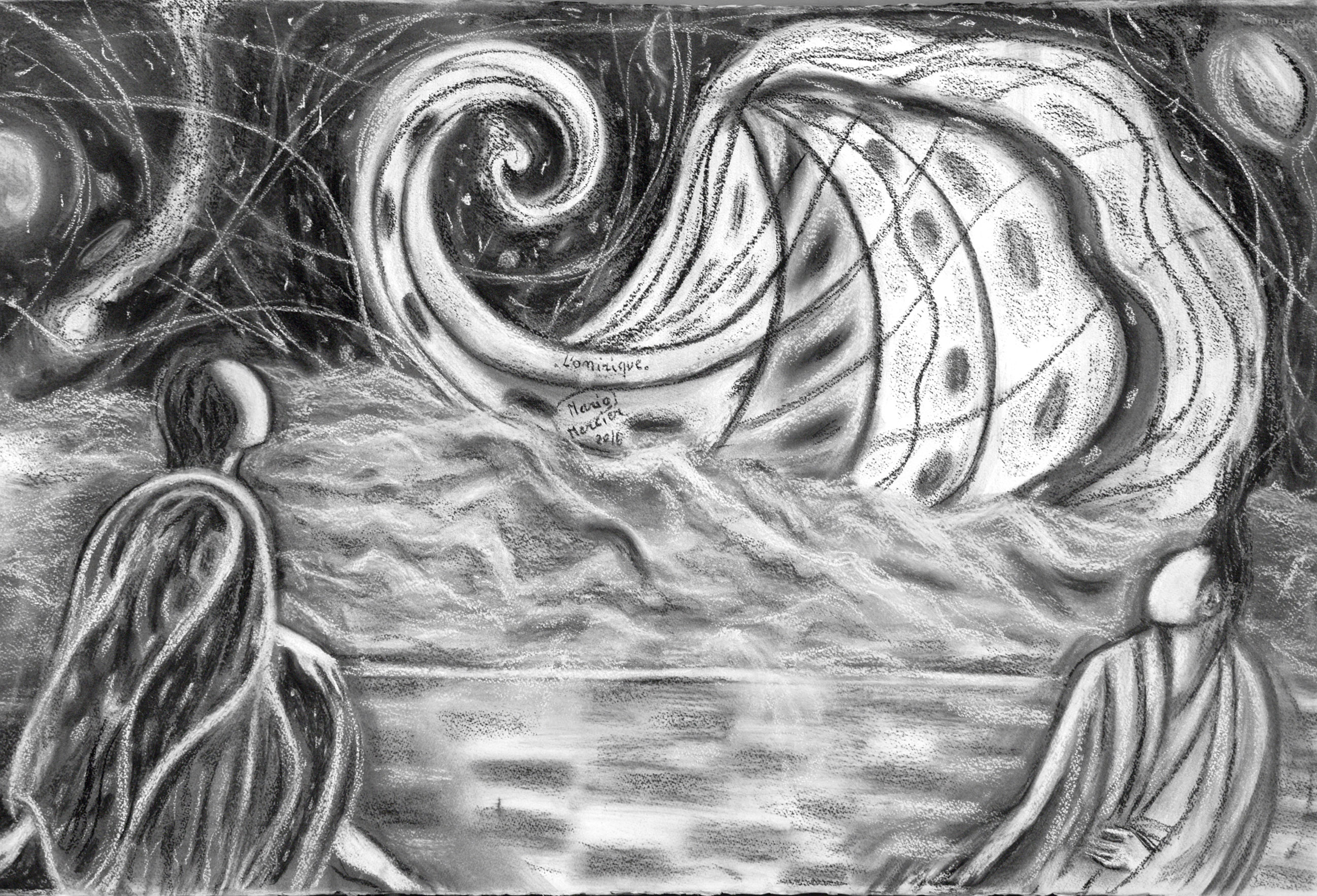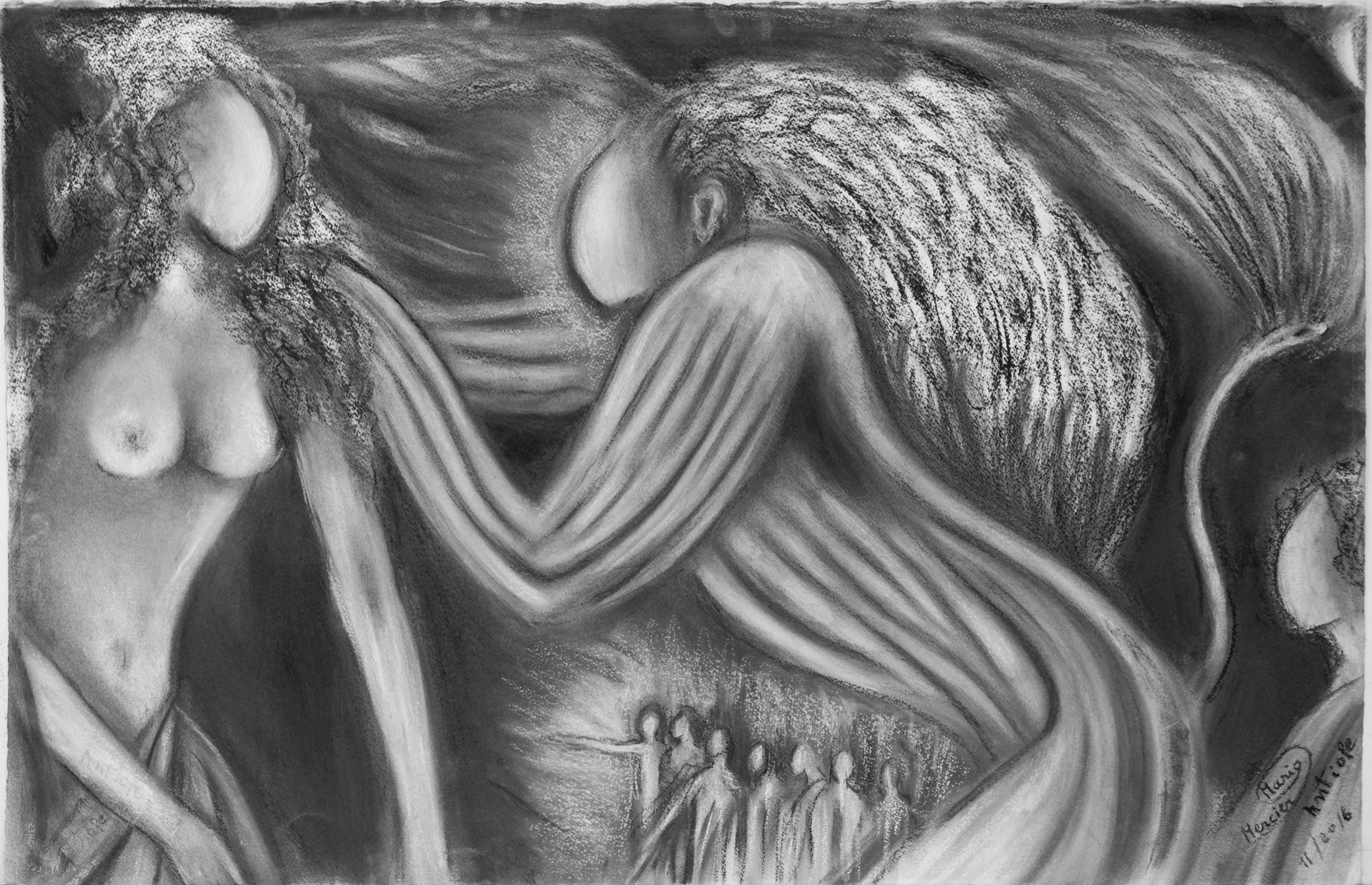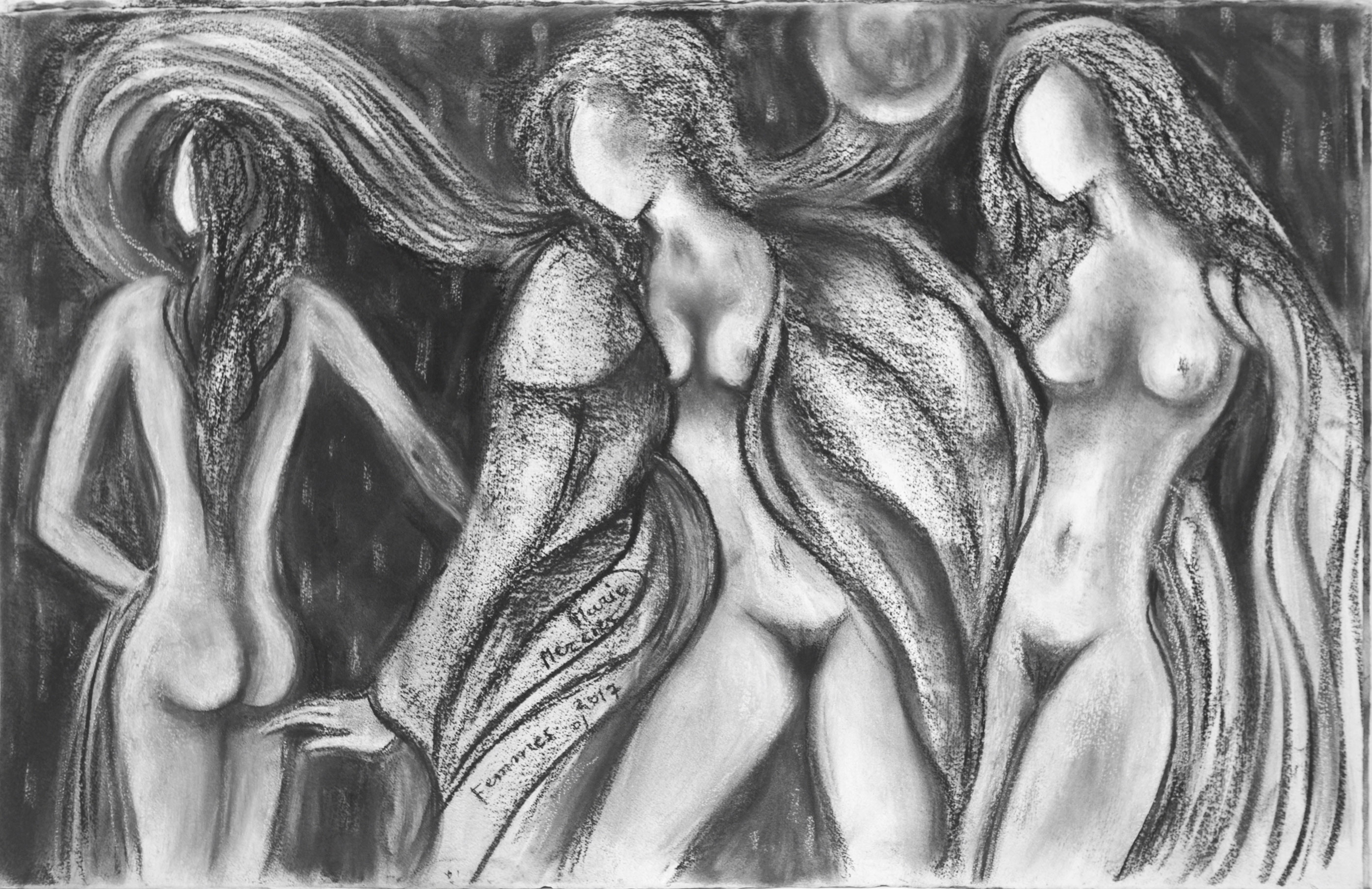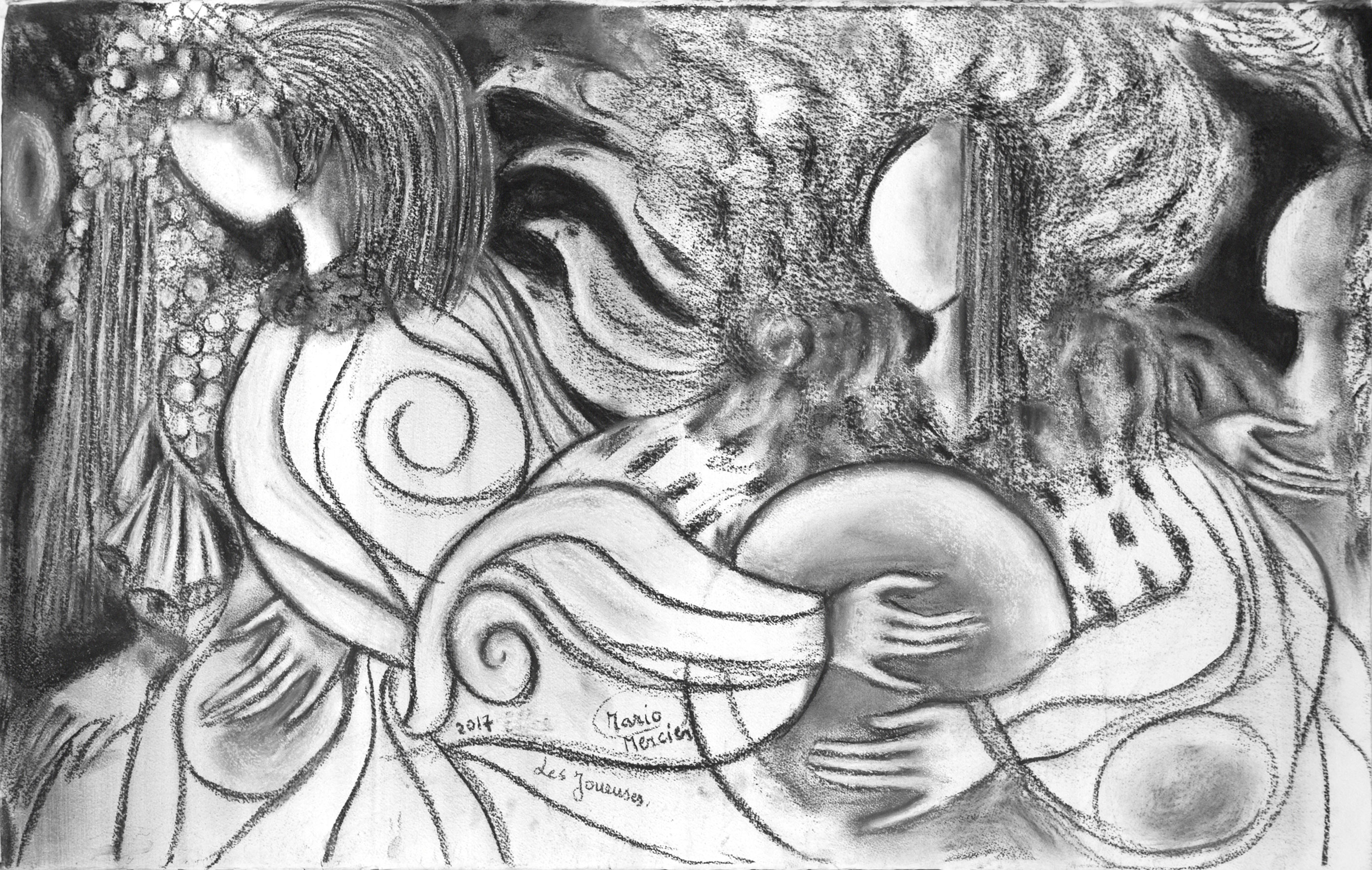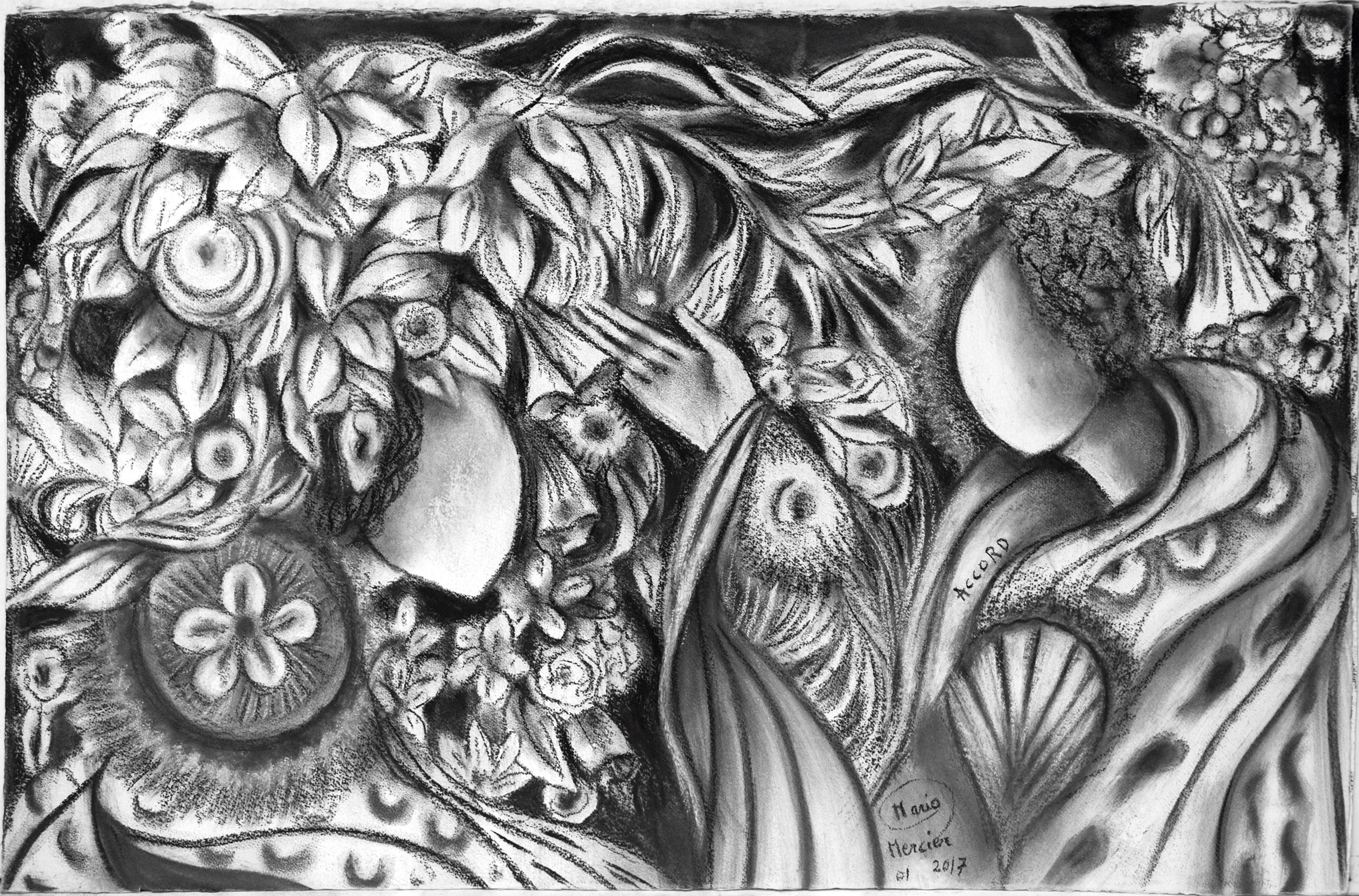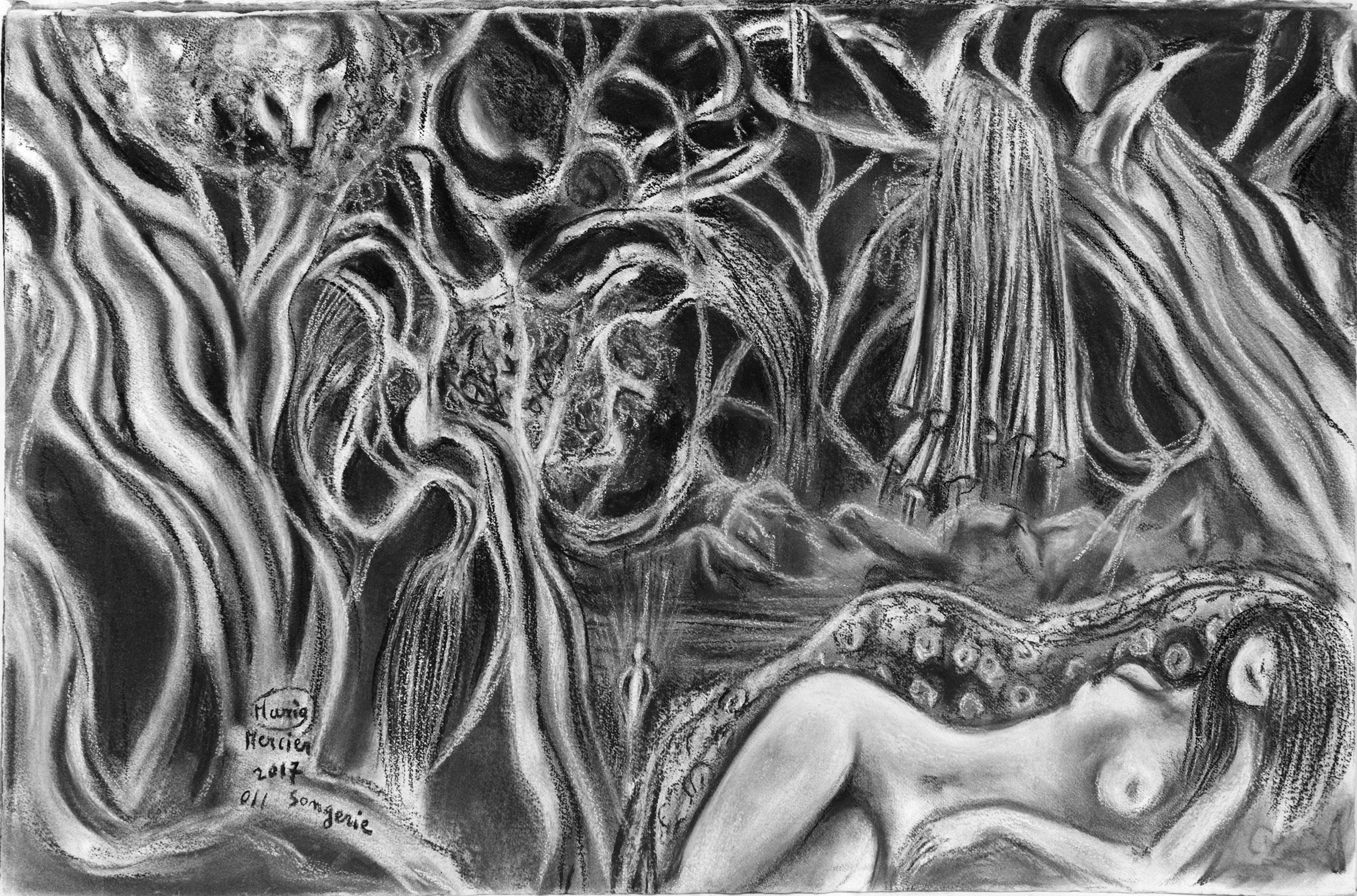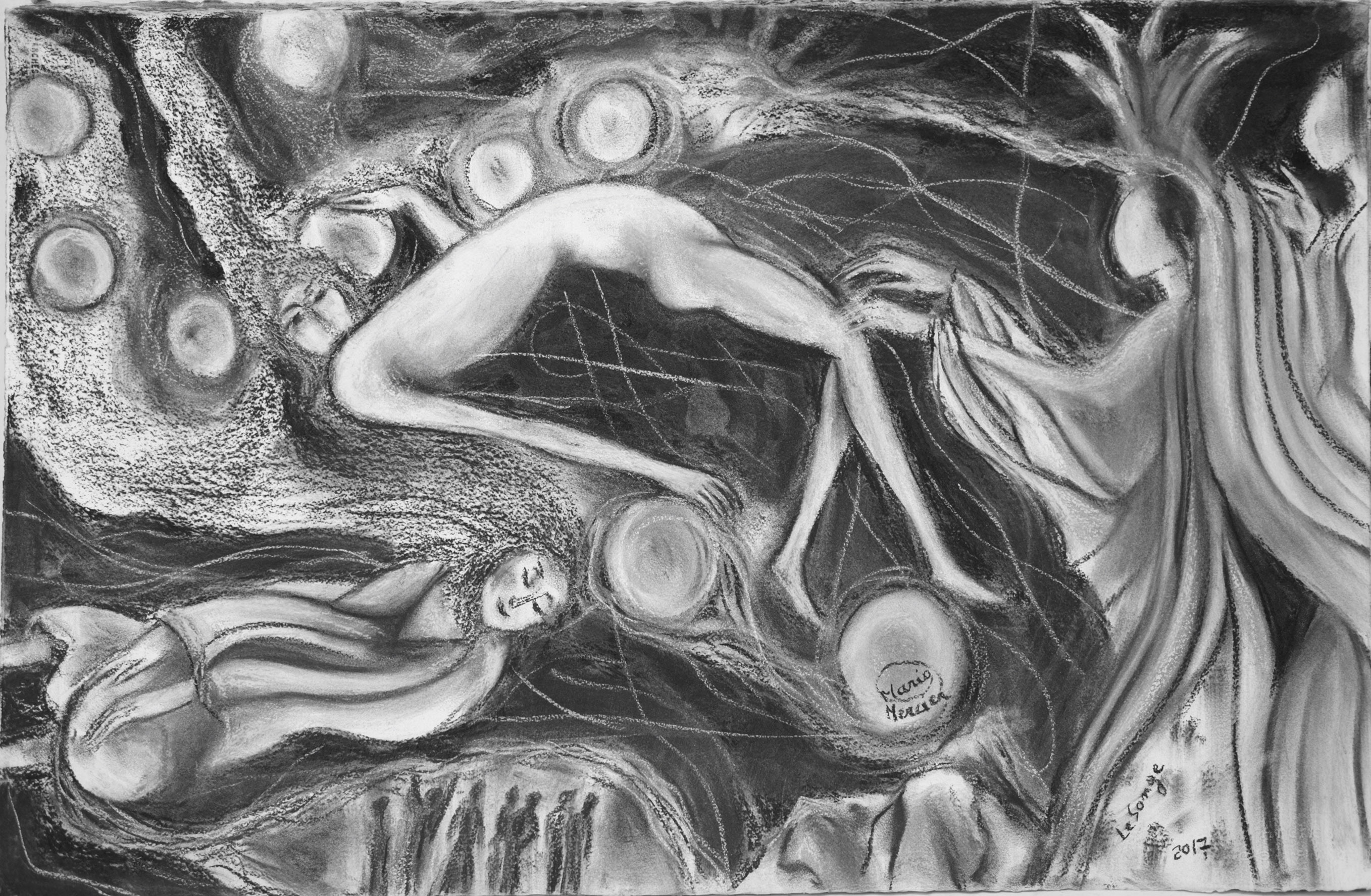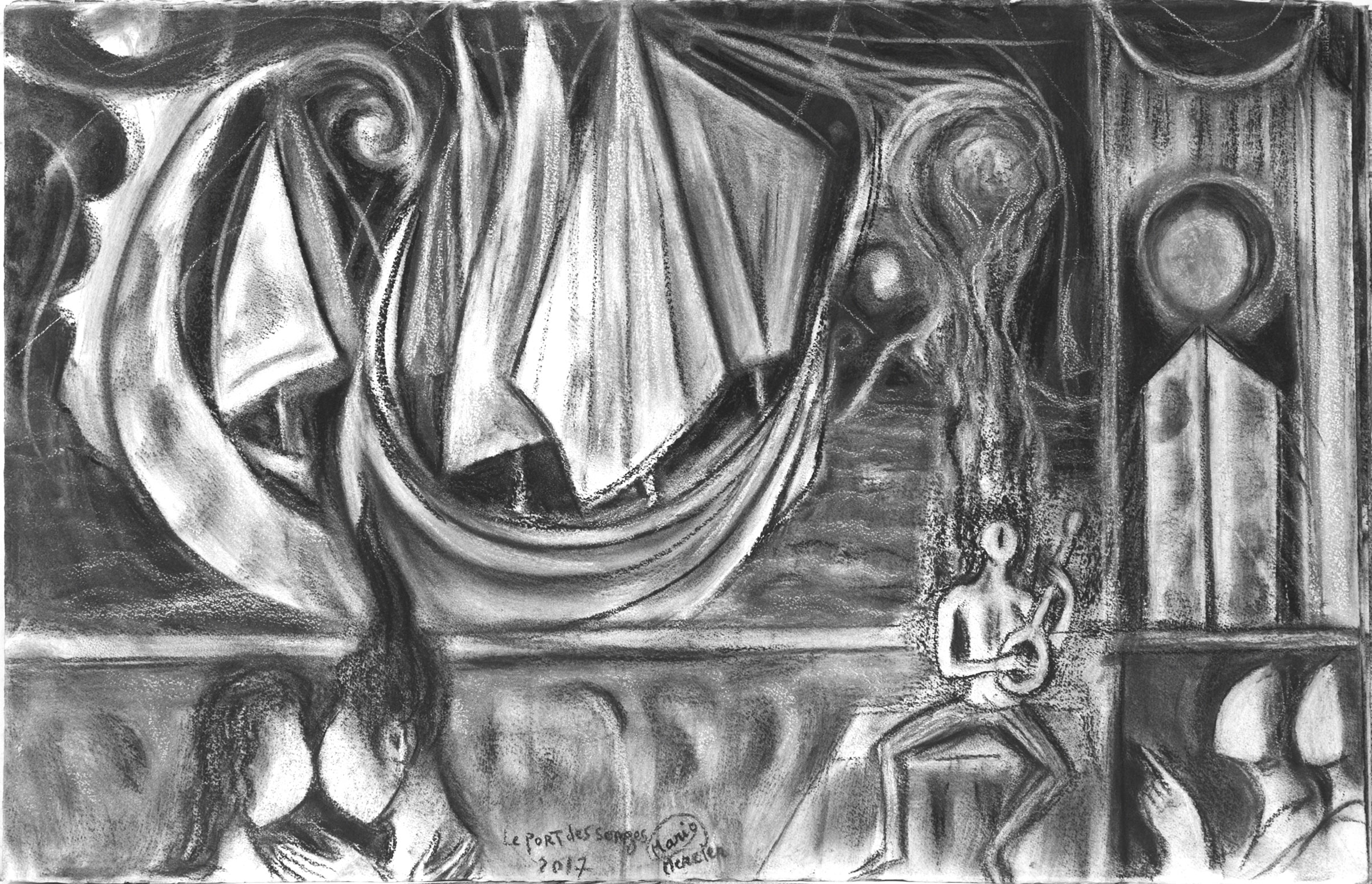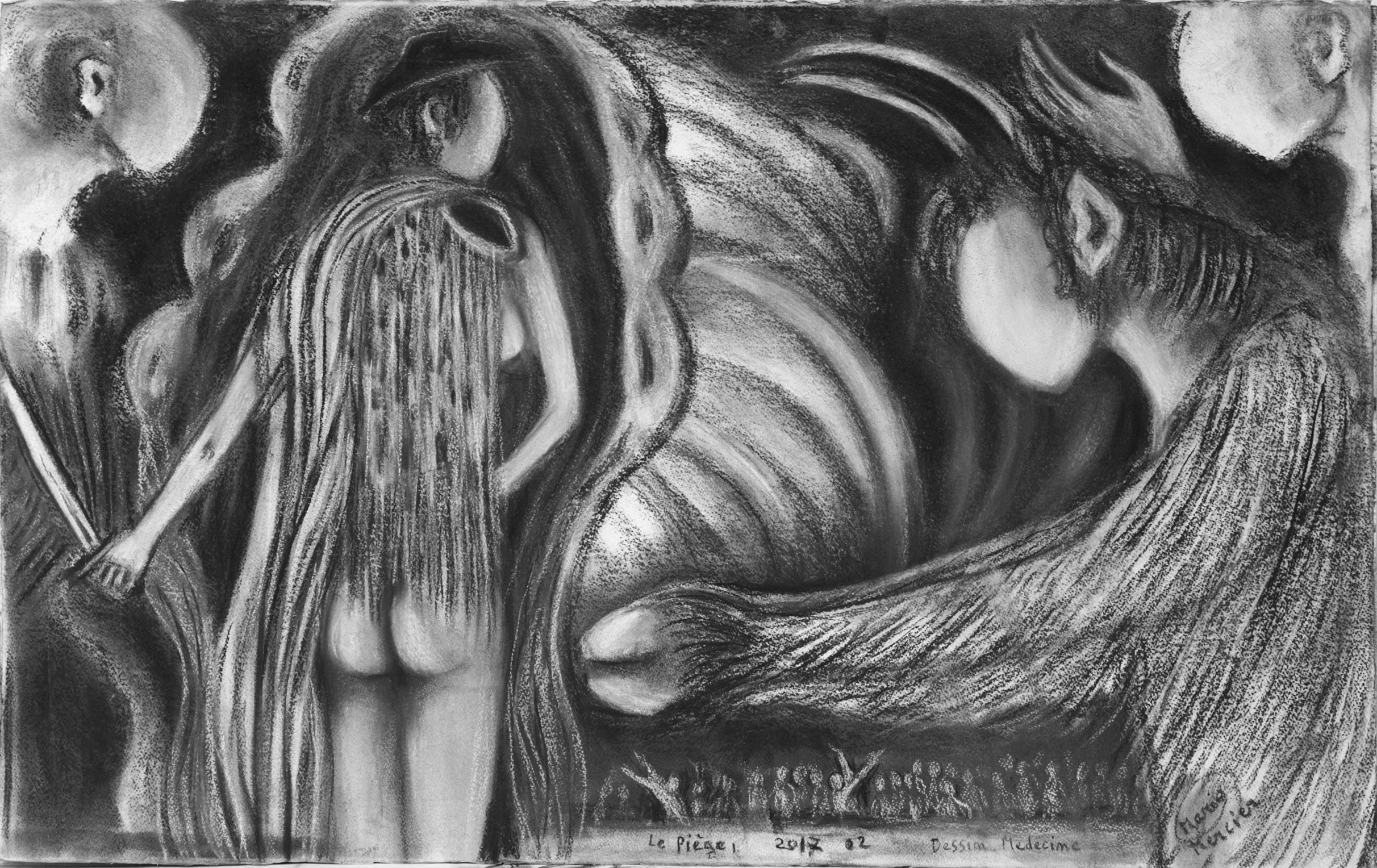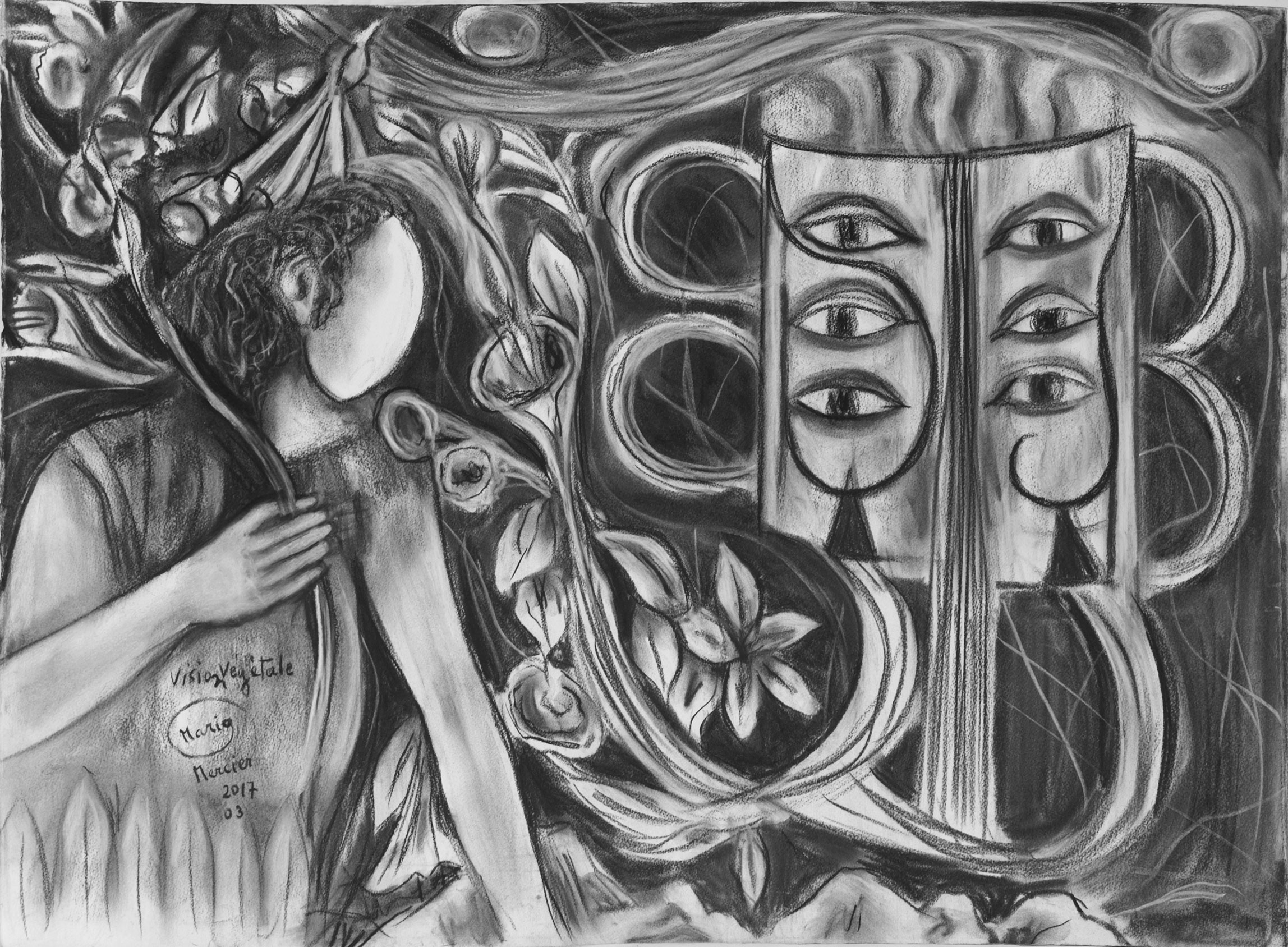Erotic Folk Horror Master Mario Mercier's New Series of CHAMANIQUE Drawings.Posted April 2017 bt 5T1V
Born in 1936, Mario Mercier is mostly known by movie buffs for his full-length films Erotic Witchcraft (La Goulve, 1972) and A Woman Possessed (La Papesse, 1974). These two films were very difficult to find, and still more difficult to view. They were presented in underground theaters in France and Quebec during the seventies. Mario Mercier was no doubt displeased with the type of criticism given to him, as well as that by the specialized French press, which didn’t seem to appreciate his films.Mario Mercier steeped himself in the very rich French tradition of writer-filmmakers, such as Fernando Arrabal, Alain Robbe-Grillet, Jean Rollin, or José Larraz. It’s scarcely surprising, in my opinion, as many filmmakers of the European fantastique show inventiveness and an indisputable aesthetic sense- the fruits of a reflection that one can follow traces of in their writings. For example, the understanding of the film work of Jean Rollin resides, to me, in the frequenting of his literary work. There is not one without the other. It is the same with Robbe-Grillet. When I learned that Mario Mercier was a writer, I immediately began inquiring about and trying to obtain his books. This was difficult on all fronts: Two of the books had been censured by the French, one was in a collection of stories by a marginal publishing company, and one book was practically lost. These searches taught me that Mario Mercier had equally published numerous works on reflection, and the spiritual search…
Still from "Les Dieux en Collere" 1970 1970"These drawings are are a surprising balancing act between the esoteric art and the historic art of the fauves and the history they perpetuated" said New York "occult art" dealer Stephen Romano, who'se curatorial credits include "Opus Hypnagogia" at Morbid Anatomy Museum (see the review in the New York Times), "Magica Sexualis" co-curated with artist Barry William Hale which was deemed the best occult culture event of 2015 by Spiral Nature, among many others. "This work feels to have been born as hybrid of the Fauves, HAXAN, Jacob Bohme and Carlos Casteneda, and a true concern and avocacy for spiritual growth and healing rather than SCHOCK / POP varitety of so called "horror art" we see perpetuated today. "Romano added " I have a collection of Mario Mercier euphemera. His cinematic masterpiece "La Goulve" from 1972 is a masterpiece of esoteric erotica and was decades ahead of it's time. Like most true visonaries however, such as William Mortnesen and Darcilio Lima, he was too much for his time, too much to be digested by the audience, and was subsequently left unacknowledged for the genius his slim catalog of films allude to."
Stills from restored "La Goulve" 1972
"The truth is, Mario Mercier's oeuvre belongs in a special Parthenon of artist who's role is as shaman in our culture, to use art as a weapon against the shrinking and dumbing down of our consciousness, and instead an attempt to empower the artist and viewer alike with a higher purpose, one of the healer, the conduit by which we are unified, not separated and pitted against one another because of our difference. The role of the artist as shaman is to re-inject the sense of hopefulness, optimist, wonder and magic into our culture. This is what Mario Mercier's works, be they his early cinematic efforts, his novels or his drawings were intended for.."Aeron Alfrey, who directs the popular site monsterbrains.com said of Mario Mercier's art: "The work of Mario Mercier is haunted by featureless mannequin like characters drifting through fragmented dreamscapes. The charcoal medium plays into the idea that each scene is filled with wisps of smoke, ghostly forms solidified into deranged configurations. The warped symbology of dream logic is strewn through narrative moments of unknowable events, leaving behind questions better left unanswered."New York artist and singer Alexis Karl, who'se artwork was exhibited alongside vintage press photos (see below) of Mario Mercier's "La Goulve" in BLAM Gallery's "Materia Prima" exhibition, said of the works: "Mario’s work is like dream-walking into another world.. one that seems to hold the arcane secrets of sex and magic, one that dives into darker realms of consciousness and thrums with the essence of ritual. He is myth writing, quietly reminding us of tales we have always know, but have somehow, in this loud urban world, managed to forget."Artist Barry William Hale, who'se art practice includes ritual elements and exhibited alongside lobby cards of Mario Mercier's "La Goulve" at the Morbid Anatomy Museum in Brooklyn said the following in response to Mercier's drawings:"Mario Mercier is infamous for illuminating tales of Witchcraft, Magick & Possession on controversial Celluloid'. Lesser know is the dark ‘Chamanic’ world of his Charcoal drawings which speak in images of a dark and personal spiritual world which seems to exist in a liminal Arcadia somewhere between the celestial and chthonic. In his drawing we see the exotic esoterica of his film making expressed in the sensuality of line, and dreamlike quality which seems to illustrate an elaborate and deeply personal mythical narrative.
|
MARIO MERCIER: WITCH CINEMA: On his Films and Novels and the Fantasticby Frédérick Durand Translated by Mandy Hoff originally published on esotikafilm.com Special thanks to Mike Kitchell for permission to re-publish .
Over the last few years, the appearance of DVDs has allowed the works of numerous filmmakers to reach a sizable public. If the name of Jess Franco, for example, has become well known by the American public, it’s essentially thanks to restored editions of his films, which had generated a significant interest toward the filmography of this Spanish director. It would be advantageous that, for once, technology would allow unknown but talented authors to come out of the shadows. Here, I think of names such as José Bénazéraf, Jean-Louis Van Belle, or... Mario Mercier, whose film A Woman Possessed (La Papesse), came out last year on DVD in region 1 of the United States, by Pathfinder/Asterix, in the cadre of a "French Erotic Collection.” If it hadn’t been for a fire a few months later that destroyed the warehouse of the Société d’Édition Les Belles Lettres, the publication of Oeuvres complètes de Mario Mercier (The complete works of Mario Mercier) would have allowed for the complete rediscovery of Mercier begun by the republishing of Journal de Jeanne (Jeanne’s Journal) by Musardine Editions, in 1998. But who is Mario Mercier? The remarkable journey of this man of multiple talents will give one idea. I no longer remember where I heard his name for the first time. Always being interested in European genre cinema (Italian, Spanish, French, British, or German), I must confess a weakness for the French and Spanish fantastique, two styles unfortunately still unrecognized. Regrettably, French fantastique film in the seventies is not rich in auteurs, the most prolific being without contest, Jean Rollin. To their defense, some filmmakers like Michel Lemoine, Bruno Gantillon or Raphael Delpart attempted to make fantastique films three or four times. Others, like Jean-Francois Davy, Joel Seria or Jean Daniel Verhaeghe each directed only one significant production, making it even more regrettable to amateurs that their brief incursion into this bizarre territory had been so quickly replaced by comedies, documentaries, or other more profitable enterprises that were less risky and, consequently, often less interesting. Born in 1936, Mario Mercier is mostly known by movie buffs for his full-length films Erotic Witchcraft (La Goulve, 1972) and A Woman Possessed (La Papesse, 1974). These two films were very difficult to find, and still more difficult to view. They were presented in underground theaters in France and Quebec during the seventies. We are able to see this in the reproduced pressbooks, and also in the published reviews of the yearly logbooks of l'Office des Communications Sociales, an organization charged with the evaluation of the artistic value of films presented in Quebec. In these pages, Mario Mercier was no doubt displeased with the type of criticism given to him, as well as that by the specialized French press, which didn’t seem to appreciate his films (see in particular the opinions written in Vampirella on the subject of A Woman Possessed, where it continually received bad reviews).
Mario Mercier steeped himself in the very rich French tradition of writer-filmmakers, such as Fernando Arrabal, Alain Robbe-Grillet, Jean Rollin, or José Larraz. It’s scarcely surprising, in my opinion, as many filmmakers of the European fantastique show inventiveness and an indisputable aesthetic sense- the fruits of a reflection that one can follow traces of in their writings. For example, the understanding of the film work of Jean Rollin resides, to me, in the frequenting of his literary work. There is not one without the other. It is the same with Robbe-Grillet. When I learned that Mario Mercier was a writer, I immediately began inquiring about and trying to obtain his books. This was difficult on all fronts: Two of the books had been censured by the French, one was in a collection of stories by a marginal publishing company, and one book was practically lost. These searches taught me that Mario Mercier had equally published numerous works on reflection, and the spiritual search… “Concierge in a psychiatric hospital, decorator in a funeral home, painter (of 'the esoteric school' in Nice)”, Mercier carried out a lot of work, in the manner of numerous “popular” writers. His first book, Journal de Jeanne (Jeanne’s Journal), came out in the well-known publications of Eric Losfeld/Le Terrain Vague in 1969. Eric Losfeld was known for being one of the avant-garde editors who, in the manner of Jean-Jacques Pauvert, worked to promote diverse types of literature; startling, and original in different styles (erotica, fantastique, science-fiction, and detective). After all, his slogan was “Eric Losfeld leaves the ordinary knocking on the door.” Eric Losfeld was the first editor to have a French review entirely dedicated to fantastique cinema: Midi-Minuit Fantastique, in which all 24 issues are remembered fondly by amateurs of the fantastique and eroticism. There, they’ve rubbed elbows with prestigious names like Francis Lacassin, Ado Kyrou, Jean Rollin, Alexandro Jodorowsky, Forrest J. Ackerman, and numerous others. Journal de Jeanne had the effect of a small bomb when it was released and Losfeld was rapidly taken to trial. In his autobiography Endetté comme une mule : Ou La Passion d’éditer, Eric Losfeld wrote:
Journal de Jeanne was the cause of my first big trial, followed by others, even for the books I’ve published previously […]. Mario Mercier arrives one morning. I tell him:
There is certainly humor in Mercier’s book, but it is fierce and often bitter. Upon reading, one wonders, if Mercier could get a large enough budget, if a film adaptation would even be possible. Incredible phrases punctuate the story, like: “In the slaughter room, death did not know whether it was coming or going.” (Dans la sale d’abattage, la mort ne savait plus où donner du néant). When the book is again closed, one is left with a strange impression, especially since its ending is as unnerving and unpredictable as the rest of the book. The finale, where M. and J. meet, inspires me to form a rather audacious hypothesis: was this 'M.’ the author, and ‘J.’ his character? What if Jane really existed? I understand then the admiration of Andre Pieyre de Mandiargues before an imagination this unbridled. Mandiargues, a short story writer, novelist, and poet (Goncourt Prize 1967 for his fantastique novel La Marge) wrote this letter to Eric Losfeld shortly after the publication of Jeanne’s Journal: Dear Eric,
After this collection of short stories, Mario Mercier published The Necrophiliac, with Jerome Martineau, which was completely censored. In this book, Mercier recounts the last days of a necrophiliac who is the prey of his own hallucinations. Between two expeditions to the town on a quest for new prey, he comes upon some dream-like misadventures, like the discovery of a couple in the middle of burying a baby. The ‘new age’ aspect that we see in Mercier’s works in the 70’s is already present, seen in particular the allusion to one of his ideas: that our life on Earth is nothing but a passage through a plane of existence, and Death is nothing but the start of exploration of another plane of existence. This novel, though interesting, is the least original of Mercier’s works. It must be said that the theme had often been addressed, and the realistic predisposition of the author prevents this book from reaching the same level of outrageousness that characterized his first two publications, though one does still find the same esoteric writing and malicious tendencies.
9.In 1972, Mario Mercier was able to direct his first full-length film: La Goulve. However, this wasn’t the author’s first ‘dive’ into cinema, as he had previously directed a short film, Les Dieux en Colère. Referring to the reproduced photo in Midi-Minuit Fantastique (Nov. 1965, last photographic section); we knew absolutely nothing of the film and the still only augmented our curiosity. It is otherwise possible that Mercier had directed other short or medium length films before. La Goulve was produced by Bepi Fontana (Ex-conductor of a Latino orchestra, Bepi Fontana has taken his career path in an unexpected direction: he now directs the online marriage agency ‘Coeur à Coeur”), who, finding the finished product too unmarketable, took it upon himself to add other scenes that changed the nature of the film. Nevertheless, Cathal Tohill and Pete Tombs speak of it positively in their own work, Immoral Tales: "The cast are obvious amateurs and the costumes homemade. At one point the camera pans along a row of witches, posed to reveal their stockinged thighs. One of the girls winks broadly into the lens. For some inexplicable reason the effect is not to dissipate the tension of the scene. It heightens it. We are watching a home move. But one made by someone with very serious intentions. Obsessive. Someone who sees things that he is desperate to show us. At any cost. […] Watching Erotic Witchcraft is like having the top of your skull taken off and blown into. It shakes up your preconceptions about cinema and what it is and should be. Finally you know that you are seeing the world in a new way, through eyes that have a different perspective from the rest of us.”
Mario Mercier’s mind was never occupied with thought of censorship. According to Tohill and Tombs, “Again the subject of [La Papesse] is witchcraft, but this time the fictional elements are kept to a minimum. The cast are mostly members of an existing sect and the ‘Papesse’ of the title is a genuine adept- Géziale. La Papesse shows scenes of real possession, secret rites and initiations […] What [Mercier and Jean Rollin] share is a rare ability to visualize those states of existence that are beyond the rational, beyond analysis. For that reason they, like any others who venture into similar terrain, will always run the risk of being not only misunderstood but openly ridiculed- unless they have the safety net of a big budget and ‘artistic’ pretensions to protect themselves with. As Mario Mercier wrote: ‘Death by silence is the fate of all who refuse to follow the safety of the well trodden paths. But whoever dies such a death can always place his hopes in resurrection.’” As I mentioned earlier, the critics of the time had scarcely recognized La Papesse, and I don’t recall ever having read a single positive review of this title (including in the specialized reviews), except that of Tohill and Tombs. The Catholic critiques this time were entirely indignant: The Catholic Office of French Cinema labeled it as “perverse” and listed it among the films “not to be seen” (Season 1975, p.348). In Quebec, it received the following contemptuous critique: “A hodgepodge of occultism and eroticism […], this film more than satisfies the viewers' and the amateurs’ quota for ugliness. The acting is done at the level of an inept amateur. This film takes the pretext of esoteric practices to compile scenes of sadism and perversion." (Recueil des films de 1975, p.142).
After so many problems, Mario Mercier returned to writing. The final novel characteristic of his first period is L’odyssée fantastique d’Arthur Dément (1976), his second masterpiece after Jeanne’s Journal. Also published by Losfeld, this book recounts the strange adventure of a secret passenger on board a ship navigated through haunted seas carrying a cargo of monsters and other bizarre creatures. Arthur stops in nightmarish lands… notably of the Ile de la Goulve de Ténèbres! He meets strange life forms, such as the Hell Hounds (“de grosses gueules écumeuses animées par l’influx magnétique des orages. Ce sont des matérialisations spatiales de la mort” p. 101) and the Obscurs (“ Les regarder à l’œil nu gèle la vue” p.123). A curious mix of humor, delirium, and pure terror, the book seems to have passed unnoticed. All the more unfortunate, as this commercial failure marked the end of “Fantastiquer Mercier,” who then focused more on books in which the ‘fantastique' was more a mode of life: spirituality, esotericism, personal quest. The first of these books was Chamanismes et Shamans (Belfond, 1977) and was soon followed by Le Monde Magique des rêves (Dangle, 1980). Chamanisme et Chamans looks at the status of shamans throughout the world, by journeying to these chosen ones and examining their gifts, practices, history, their daily lives, and their powers. The highlight of Chamanismes et Chamans is in the last chapter, which is the narration of a shamanic voyage made by Mercier himself which describes a sort of descent into Hell, made to heal a friend. The author recorded his trip on audio cassette while in his trance among friends. Certain passages are reminiscent of Jeanne’s Journal. Though this was a spectacular finale for the book, this shift is significant of Mercier's change of orientation at the end of the 1970's. From this moment on, the quest towards white (positive) magic replaced the description of the universe as somber and black. Since 1978, Mario Mercier’s works on the spiritual quest are so prolific that it would be impossible to comment on all of them in the space of this article. He continues to write to this day. He has also continued to paint, as seen in an edition of poems by Arthur Rimbaud, published by Albin Michel in 1991, and illustrated by Mario Mercier. In 1994, Flammarion published the book La France de mutants: voyage au Coeur du Nouvel Age by Jean-Luc Porquet. In this work, an independent journalist attempts to investigate the gurus and adepts of the New Age. One of the chapters (Le Castenada Francais, p. 156-174) is dedicated to Mario Mercier. Porquet, without revealing his identity as a journalist, had actually participated in one of the seminars given by Mercier. His verdict is uncertain: “I have never been so bored during a lecture, but to this day, no other lecture has left me with so many troubling images." Porquet’s preconceived skepticism may have detracted from the objectivity of his study as he evaluates Mercier as a shaman/guru without taking into account the artist. He particularly accuses Mercier of embarrassing the participants of his lecture, promising miracles that never occur, and abusing the trust of those easily mislead. Opposite the work of Porquet, one of Mercier's most recent books, La Volupteuse Sagesse de la Chatte Mia (les Belles Lettres, 1997) shows us a man who is less mythical and more like us than the author of Journal d'un Chaman or the enigmatic director of La Goulve. This book reflects on the simple humor and tranquility of a life at the side of his mother and his cat Mia. In this he succeeded in putting his name on a very unique book. We can still see the wacky Mario Mercier, the author of fantastique novels of constant innovation, but the difference this time resides in the fact that this book is devoid of all cruelty. The violence present at all times in Jeanne's Journal and La Cuvée de Singes is absent here. Mercier narrates his first meeting with Mia, and the circumstances leading to her adoption, and then he engages in a dialogue with her. He becomes a comedian with phrases like: "Was there ever a cat-Jesus? Or a Buddhist cat, who would practice compassion for mice?"(p.43). He will even go as far as to invoke his animal familiars, bringing these ghosts to life in the space of a memory. Mercier’s only other novel to appear after this, Loubia (Atlantis 2000), is more like a disguised attempt at recounting the conversation between a man and a sort of woman-angel. It is clear of all darkness, and anyone reading it in the hopes of renewing a tie with the somber phantasmagoria of his first writings will be disappointed… Visiting Paris in 1999, I nevertheless was able to schedule a meeting with Mario Mercier, in the company of my good friend Pascal Francaix- a huge fan of 'B' cinema, the author of Jean Rollin, Cinéaste Écrivain (Édition Films ABC, 2002), and of many fantastique novels. Mercier chose the Café de Flore for our rendezvous, and we told ourselves that he would probably arrive late. Actually, we waited 45 minutes, scrutinizing each new arrival while trying to discern if he acted like Mario Mercier. From time to time, I would dare to go and ask "Are you Mario Mercier?" and each time I was given a funny look. However, when he arrived, Francaix and I knew right away that it was he. Dressed simply, he carried a backpack which contained some soil from his native land, which he made us smell. You can imagine our surprise, even if we expected some peculiarities from Mercier.
He was so kind as to have brought with him a copy of La Cuvée des Singes, of which he seemed to be (wrongly) ashamed, in saying, “This is an old scatological thing that I wrote some time ago.” Despite the cold indifference of the waiter at the Café de Flore (who even refused to take our picture!), the conversation livened up little by little. Mercier revealed that he had always been passionate about the fantastique, and he confessed that he still has numerous unedited novels at his home. He spoke of a terrifying novel that he had just begun to read, the title of which I have (alas!) forgotten. He’s looking for a publisher. Some negotiations have started with Pocket for republishing Arthur Dément, which would begin a new series of adventures for that character. However, Mercier and the director of Pocket, Jaques Goimard have been unable to come to an agreement. The only copy of Arthur Dément that Mercer had was stolen…! Without this version of the book, nothing seems possible. I had forgotten to mention that with the help of the French National Library, the problem might be fixed. Les Belles Lettres was perhaps interested: the director Michel Desgranges is an admirer of both Mercier and Jean Rollin (the two are very good friends), and he published the latest of Mercier's books. Mercier handed us a flier for his seminar on “personal development” which he greatly encouraged. Francaix and I didn’t comment on that much, as we aren’t interested in such things, to say the least. To be honest, the participation fee was very high. As an oracle, Mercier sometimes made some surprising statements: “You are hungry for freedom”; “You neglect your relationship with the Sea”…when we tried to ask about La Goulve, the auteur-filmmaker squarely refused to speak of it. Pete Tombs warned me! Mercier never forgave Bepi Fontana for having distorted his film... and Tombs, who had recently found a version of the film in 35mm couldn't release it on DVD for this exact reason. What of La Papesse then? La Papesse, for Mercier is another story of grand deception: a film killed by the censure and the distributors, released at the worst possible time. The Exorcist had taken away from his film, and viewing was restricted so as not to take attention away from Friedkin's film. Twenty-five years later, however, memories aren't quite as precise. I would have liked to speak of Géziale, to know what ‘La Papesse' had become and who she was, but Mercier never responded to those questions and instead wanted to know what we had done. Francaix and I did want to talk a bit about our own work, but our own careers as novelists seemed of little interest in comparison to what Mario Mercier could tell us. We learned among other things that Mercier had grown up in a house "more or less haunted," and there was brief talk of eroticism. Mercier likes, he said, an "érotisme à la Kubrick"; an allusion, I assume, to the film Eyes Wide Shut, in theaters at the time of our interview. We spoke a little of Eric Losfeld… and Mario confessed to feeling saddened upon reading that he was "but a man of a single book" in the biography of the author of Terrain Vague. For good reason... Finally, at the end of our hour long interview, we still didn't know much on Mercier. It was difficult to keep our discussion along a precise direction, and the situation didn't lend itself well to note-taking. However, we promised to keep in touch, and I told myself that for now, simply the interview would do. A few months later, Mercier contacted Francaix about publishing Arthur Dément. Francaix sent a few words to Jaques Chambon, who doesn’t like Mercier's work much. In my opinion, the ideal situation would be for it to be included in the new collection headed by Jean Rollin for E-dite. More to follow... Since then, Mercier published a play called On nén finit pas de fair la Guerre (Éditions du Cosmogone, 2002). Even though he promised to respond to my letters, I’ve not gotten any responses, except for a friendly postcard in 2001. Nevertheless, if I ever return to Paris, I will try to contact him…Until then, La Papesse will allow international fans the opportunity to know Mercier’s work, and the republishing of Jeanne’s Journal, always available at used bookstores, will allow readers the chance to discover a very talented writer, who we still hope will speak to us, in our preferred domain…
|
MON ART CHAMANIQUE Pour ce qui est de ces créations graphiques exprimant ici une relation avec le chamanisme, cet état d’être et de faire, je me suis servi, pour une accentuation graphique, d’une matière pulvérulente peu reconnue encore, mais si près de la nature, matière issue directement du bois, portant le nom de fusain.
Par lui, par ce noir qu’il exprime et sur lequel je n’ai cessé de jouer sur ses valeurs, bien qu’elles soient limitatives, de jouer en une sonate visuelle sur ses variations d’ambiance en passant du noir profond au noir léger, du gris, plus ou moins dégradé, tout en renforçant ses effets par des plages de blancs que viennent parfois velouter l’usage de craies blanches en l’occurrence.
Ainsi, les sujets traités avec une certaine liberté de lignes, propres à mon style, sont surtout basés sur une démarche visionnaire dans laquelle l’humour, ce rire de la pensée, n’est pas exclu.
C’est dans l’arrière-boutique de l’esprit, de mon esprit mêlé à un certain vécu dit chamanique, que j’ai voulu lui donner une base d’authenticité d’un vécu par-delà cette vie conventionnelle dans laquelle sont mêlés les mouvements du rêve. Tout en rendant compte de mon travail graphique, je ne peux m’empêcher de penser, entre autres, au peintre et illustrateur Odilon Redon, célèbre non seulement pour la magie de ses couleurs, huiles et pastels, mais aussi par ses lithographies et par ce qu’il appelait ses noirs qui sont les fusains dont l’usage de sa matière fut désennoblie à son époque.
Ainsi dans ses notes n’écrit-il pas, au sujet du fusain notamment : « Il faut respecter le noir (il parle surtout de ses fusains), rien ne le prostitue… Il est agent de l’esprit bien plus que la plus belle couleur de la palette ou du prisme. » Bien que je sois aussi un fou de la couleur, ces noirs que je pratique, m’ont permis de renforcer et d’exalter les pouvoirs si mystérieux et si surprenants de la pratique de cet autre dimension magique de l’esprit qu’est le chamanisme en relation, notamment, avec la Nature.
Je conclurai par cette réflexion du peintre Millet, lequel inspira quelques œuvres de Van Gogh, qui disait : « Dans l’art, il faut y mettre sa peau ».
Pour ma part, j’ai la chance d’avoir plusieurs peaux dont celle-ci participe du noir, et de pouvoir muer à volonté ; peaux dont l’une d’elles est celle que j’ai laissée par la pratique de ces fusains portant le titre que l’on sait et que je dédie à celui qui fut mon maître, Edouard Fer qui m’a appris à avoir une ouverture et une certaine maîtrise de mon art mais aussi « à voir et à aimer ».
Mario Mercier
MY CHAMANIC ART Regarding these graphic creations, expressing here a relationship with Shamanism, this state of being and doing, I used, for an accentuation Graphic, of a pulverulent matter not yet recognized, but so close to the Nature, material coming directly from the wood, bearing the name of charcoal.
Through him, through this blackness he expresses and on which I have never ceased to play on his values, Although they are limiting, to play a visual sonata on its variations From deep black to light black, gray, more or less Degraded, while reinforcing its effects by white beaches sometimes Velter the use of white chalk in this case.
Thus, the subjects treated with a certain freedom of lines, proper to my style, are Primarily based on a visionary approach in which humor, this laughter of the Thought is not excluded.
It is in the back-shop of the mind, of my mind mingled with a certain experience Shamanic, that I wanted to give it a basis of authenticity of a lived beyond This conventional life in which the movements of the dream are mingled. While reporting on my graphic work, I can not help but Think, among others, to the painter and illustrator Odilon Redon, not only famous For the magic of its colors, oils and pastels, but also by its lithographs and By what he called his blacks, which are the charcoals whose use of his material was Disillusioned in his time.
Thus, in his notes, he writes, notably about charcoal: "We must respect the black (he speaks especially of his charcoal), nothing prostitutes him ... He is a The mind much more than the most beautiful color of the palette or prism. " Although I am also a madman of color, these blacks whom I practice, have allowed me To reinforce and exalt the mysterious and surprising powers of the practice Of this other magical dimension of the spirit that is shamanism in relation, In particular, with Nature.
I will conclude with the reflection of the painter Millet, who inspired Van Gogh, who said: "In art, one must put one's skin on it."
For my part, I am lucky to have several skins of which this one participates in black, And of being able to moult at will; Skins, one of which is the one I left behind The practice of these charcoals bearing the title that we know and dedicate to the one who was My teacher, Edouard Fer who taught me to have an opening and a certain Mastery of my art but also "to see and to love".
Mario Mercier |

